Income Research Paper Series
The evolution of income mobility in Canada: Evidence from the Longitudinal Administrative Databank, 1982 to 2012
Archived Content
Information identified as archived is provided for reference, research or recordkeeping purposes. It is not subject to the Government of Canada Web Standards and has not been altered or updated since it was archived. Please "contact us" to request a format other than those available.
by Xuelin Zhang, Habib Saani, and Jackson Chung
Abstract
The study examines the evolution of family income mobility for Canadian taxfilers from both the absolute and the relative perspectives. Using data from the Longitudinal Administrative Databank for the years 1982 to 2012, we estimated several income mobility statistics for overlapping panels of Canadian taxfilers over those 30 years. We found that absolute income mobility became stronger in the last 15 years of the period than in the first 15 years. In particular, Canadian taxfilers experienced stronger income growth in the last 15 years than their counterparts in the first 15. We also saw that a higher proportion of taxfilers had rising rather than falling income in the last 15 years than in the first 15. Across groups, we observed that absolute mobility for taxfilers aged 18 to 24 became weaker than that for other age groups, starting in the early 2000s. However, we found relative mobility for Canadian taxfilers followed a downward trend starting in the early 1990s. As well, a declining proportion of the taxfilers changed income deciles since the early 1990s, and the number of deciles changed also fell, if slowly. Across groups, taxfilers aged 65 and older saw strong declines in relative mobility, mainly because of a decline in their upward mobility. We also found that the incomes of taxfilers from both the lower and top deciles had become less mobile. Finally, we assessed the impact of mobility on long-term income inequality. We found that the relative mobility of Canadian taxfilers had a diminishing mitigating effect on long-term income inequality over time.
1. Introduction
Statistics Canada regularly produces cross-sectional income statistics of Canadian households and individuals. While these statistics help policy makers and the public understand many facets of the economic well-being of Canadians, they provide little information on income mobility — how a person's family income changes over time, either relative to their previous family income or relative to other persons' family incomes. This study attempts to fill that gap.Note 1
For many researchers, income mobility has both an absolute component and a relative component (Fields, 2008). While absolute mobility can be measured by changes of income of an individual relative to their previous income, independently from the incomes of his counterparts in the same economy, relative mobility depends on both the income of the individual in question and incomes of other people.Note 2 Both types of statistics help us assess the economic well-being of the population: absolute mobility tells us whether an individual is doing well in their own right, while relative mobility tells us how an individual moves up or down along the distribution ladder and whether they are doing better or worse than their counterparts in the same economy.
Statistics on income mobility also help us understand income inequality.Note 3 On the one hand, as Friedman (1962) put it, income mobility contributes to social mobility, and thus has the potential to enhance equality of opportunity. In this sense, higher income mobility facilitates the equality of income and the equality of other socio-economic outcomes. On the other hand, income mobility affects long-term income inequality. Consider a simple two-period economy. In the first period, half of the population possess all of the income of the economy; but in the second period, the other half takes their turn possessing all the income. Although income inequality is high in each period, the 'long-term' or permanent income inequality would be low in the economy. Of course, inequality also affects income mobility. For example, when inequality is high, it will likely take a longer time or more effort for someone from the bottom to move to the middle or top of the income ladder. Given the close relationship between inequality and mobility and the recent increase in income inequality, Canadians' growing interest in income mobility is not surprising.
An extensive literature explores income mobility in the United States, Canada and other countries. Most American studies found considerable mobility in the United States. But generally, individuals and families had not moved very far from their initial income positions, and the overall relative mobility in the United States dropped (or changed little according to some authors) over the period from the 1970s to the early 2000s.Note 4 Canadian researchers also made important contributions in this area. But unlike American researchers, who paid attention to both individual and family income mobility, almost all Canadian studies focused on the earnings mobility of the working-age population.
Kennedy (1989) was one of the earliest. He examined the earnings instability of middle-aged Canadian men with continuing labour force attachment. One of his findings was that few mature individuals were able to make large long-term gains or losses relative to their cohort. A series of papers by Finnie (1999), Beach (2006) and Beach and Finnie (2004) also studied the earnings mobility of working-age Canadians. Rather than focusing on a single aggregate measure of mobility as did Kennedy (1989), they examined in detail the patterns of change in earnings position across the distribution. One of the key findings from these authors is that, from the 1980s to the 1990s, men's earnings mobility generally declined, and only young and prime-aged women saw increased earnings mobility. More recently, Lammam, Karabegović and Veldhuis (2012) examined a cohort of Canadian workers' earnings mobility pattern during the last 20 years.Note 5 They found that people from the bottom of the distribution experienced the greatest relative and absolute earnings mobility.
Clark (1997) was the first to focus on income (instead of earnings) mobility in Canada. She examined income mobility under the transition matrix approach for the 1989-to-1994 period with data from the Longitudinal Administrative Databank (LAD). Her income concept was total or before-tax income (earnings plus government transfers). Other Canadian studies on income mobility have used data from the Survey of Labour and Income Dynamics (SLID). Chen (2009) was the first study on mobility of family after-tax income. He examined differences in mobility among Canada, the United States, the United Kingdom and Germany from the 1990s to the early 2000s. He found that income mobility in Canada was moderate relative to the other three countries, owing to the stabilizing effect of government transfers. Recent Statistics Canada releases suggest that long-term relative income mobility was stable between the 1999-to-2004 and the 2005-to-2010 periods.Note 6 Finally, Bibi, Duclos and Araar (2011) examined the welfare benefit of income mobility and the tax system over time. They found that, while mobility enhances equality, its effect was not as strong as that of taxation.
The current work attempts to draw a more complete picture of income mobility in Canada. The main objective is to assess the evolution of family income mobility in Canada during the last 30 years. It builds on Canadian studies on earnings and income mobility. Like Chen (2009), Bibi, Duclos and Arrar (2011) and following the practices of Statistics Canada (2011, 2012), we examine income mobility where each family member is assigned an income position according to their family's adjusted after-tax income.Note 7 However, our approach differs from previous studies in several ways.
First, our work is the first Canadian study to use the LAD to assess the after-tax family income mobility. By focusing on income mobility, we are not suggesting that it is unnecessary or inappropriate to examine earnings mobility. What we would like to emphasize is that income and earnings are not the same concept, and that statistics on income mobility and those on earnings mobility answer different questions. Studies on earnings mobility help reveal whether the labour market functions well. But to assess economic well-being and inequality, it is more important to focus on income, particularly after-tax income. After-tax income reflects both market and non-market forces, and is a closer proxy to disposable income than earnings or total income. In the Canadian context, studying income mobility also enables examination of the well-being of a wider population. Recent data show that roughly 20 percent of Canadians had no market earnings.Note 8 Focusing only on earnings would prevent researchers from examining the well-being of this segment of the population.
Second, we take full advantage of the available data, and pay particular attention to the evolution of income mobility in Canada. Owing to limited data access or other considerations, some researchers chose to work with one or another arbitrary time period to assess how income mobility evolved in Canada. But it is well known that income mobility measures are affected by different economic circumstances. For example, income would normally increase over the period of economic expansion and decrease over the period toward recession. The choice of the time period may affect one's conclusion in important ways. Starting at the peak of the business cycle and ending at the trough would probably lead one to conclude that absolute mobility had declined. However, choosing a different starting or ending year may lead to a very different conclusion. In the current work, we try to fully utilize the data to account for the impacts of economic fluctuations on mobility estimates.
Third, we link income mobility with inequality by looking at the potential impact of mobility on long-term income inequality (Field, 2010). As mentioned before, Bibi, Duclos and Araar (2011) examined the welfare benefit of income mobility and found that mobility may enhance equality. These authors followed the "spirit" of Shorrocks (1978) with a different concept and methodology. Our work, however, fully follows the Shorrocks concept and method based on the transition matrix approach.
Finally, our work has a specific purpose in mind – we attempt to set up the groundwork for producing a regular series of income mobility statistics for Canadian taxfilers in the future.
The rest of the paper is organized as the following. In Section 2, we discuss the LAD and the sample employed in the study; Section 3 focuses on the trends in absolute mobility; Section 4 presents our results on relative mobility; in Section 5, we attempt to link mobility with long-term income inequality; Section 6 summarizes the results and concludes this study.
2. Data and sample
We use Statistics Canada's Longitudinal Administrative Databank to assess the evolution of family income mobility in Canada. LAD is a 20% sample of the T1 Family File (T1FF), constructed using information from individual income tax returns and other administrative sources. It is well suited to our purpose. First, its very large sample size enables us to finely classify individuals across the income distribution and other individual characteristics. Second, LAD data are available for every year since 1982, permitting us to construct long, short, consecutive and overlapping panels of taxfilers that facilitate the study of the evolution of income mobility. Third, the LAD also inherits a set of demographic and family characteristics from the T1FF, such as age, sex and family type, facilitating comparison of income mobility between different groups of individuals over time.
However, as an administrative database, the LAD lacks important information such as hours worked, wage rate, school attainment and work experience. These disadvantages prevent certain types of analyses on income mobility, such as the links between mobility, labour market inputs and human capital. Nevertheless, previous studies using LAD data show that it is still very useful for producing statistics on various mobility statistics—for Canada as a whole and for various groups of taxfilers.
The unit of analysis in this study is individual taxfilers. We select only those 18 years old or older in the first year of observation. Since only a very small portion of those who are younger than 18 would file a tax return anyway, the age restriction makes our sample more representative of the target population of all taxfilers 18 years old and older.Note 9 We also exclude deceased taxfilers, and taxfilers associated with a deceased person, to avoid attributing the income of the deceased person to the living taxfilers. Taxfilers living outside of the 10 provinces are also excluded.
Even though individuals are the unit of analysis, their positions in the income distribution are determined by their adjusted after-tax family income. 'Family' here refers to a census family, which is the only family concept available in the LAD. Adjusted family after-tax income is defined as the sum of after-tax income earned by all family members divided by the square root of the family size. The dollar amount of the adjusted family income is assigned to each family member; all dollar figures were converted into 2012 constant dollars.Note 10 The adjustment for family size aims to account for the effect of economies of scale in consumption within the family. In a sense, adjusted family income is a closer proxy to individual well-being than is unadjusted income, and it has been widely adopted in recent years.Note 11
To study income mobility, one needs to observe the same person over time, but not necessarily the same person in all years of an observation period. For example, if we look at income mobility for the period from 2005 to 2010, we could limit our study to individuals who were observed in each year, or we may limit it to those who were observed in 2005 and in 2010, but not necessarily in the other years of the period. We limited our study on absolute and relative mobility to those who were observed in the first and last years of a panel.Note 12 But in determining their income positions, such as their income deciles in a particular year, we follow Finnie (1999) to assign an income position to each taxfiler using the distribution of all taxfilers in that year, whether they were included in the panel or not.
Finally, some users have expressed concerns about a small margin of error that may exist in matching individuals with families in LAD.Note 13 For example, Finnie (2000) and other authors have used a series of rules to delete such potentially problematic records from their samples. We followed this practice in our preliminary analysis, but we found no significant difference in our mobility estimates: the trend in income mobility remained the same with or without the editing rules in place. Thus, our study will be based on data from all taxfilers 18 and older who can be observed over time, ignoring the potential mismatching issue.
3. Trends in absolute mobility
How did absolute mobility evolve during the past 30 years in Canada? We examined the pattern of income change for the consecutive and overlapping panels of Canadian taxfilers over the 5- and 10-year observation periods for the years from 1982 to 2012. For example, for the 1995–2000 panel of taxfilers, the growth of income (in 2012 constant dollars) and the distribution of the income growth were obtained by comparing family incomes in 1995 and 2000 for the same taxfilers. Since we compared the real income of the same people over time, the income growth rate and how the growth rate varied between taxfilers would provide measures of absolute income mobility.
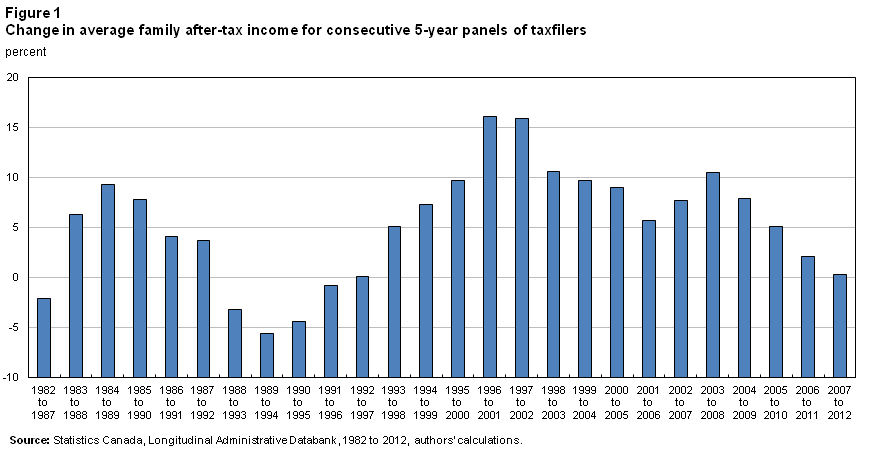
Description for Figure 1
The title of the graph is "Figure 1 Change in average family after-tax income for consecutive 5-year panels of taxfilers."
This is a column clustered chart.
There are in total 26 categories in the horizontal axis. The vertical axis starts at -10 and ends at 20 with ticks every 5 points.
There is 1 series in this graph.
The vertical axis is "percent."
The units of the horizontal axis are years from 1982 to 2007.
The title of series 1 is "Change in average family after-tax income."
The minimum value is -5.7 occurring in 1989.
The maximum value is 16.1 occurring in 1996.
| percent | |
|---|---|
| 1982 to 1987 | -2.1 |
| 1983 to 1988 | 6.3 |
| 1984 to 1989 | 9.4 |
| 1985 to 1990 | 7.8 |
| 1986 to 1991 | 4.1 |
| 1987 to 1992 | 3.7 |
| 1988 to 1993 | -3.2 |
| 1989 to 1994 | -5.7 |
| 1990 to 1995 | -4.4 |
| 1991 to 1996 | -0.8 |
| 1992 to 1997 | 0.1 |
| 1993 to 1998 | 5.1 |
| 1994 to 1999 | 7.3 |
| 1995 to 2000 | 9.7 |
| 1996 to 2001 | 16.1 |
| 1997 to 2002 | 15.9 |
| 1998 to 2003 | 10.6 |
| 1999 to 2004 | 9.8 |
| 2000 to 2005 | 9 |
| 2001 to 2006 | 5.7 |
| 2002 to 2007 | 7.7 |
| 2003 to 2008 | 10.5 |
| 2004 to 2009 | 7.9 |
| 2005 to 2010 | 5.1 |
| 2006 to 2011 | 2.1 |
| 2007 to 2012 | 0.3 |
| Source: Statistics Canada, Longitudinal Administrative Databank, 1982 to 2012, authors' calculations. | |
Several observations can be made about the evolution of absolute income mobility among Canadian taxfilers. First, absolute mobility is linked closely to the fluctuations in the economy and the labour market; Figure 1 illustrates this point. It contains the changes of average after-tax family income experienced by the consecutive, overlapping 5-year panels of taxfilers. Figure 1 shows that the recession of the early 1990s had a strong impact on absolute income mobility. Taxfilers from the 1988–1993, 1989–1994, 1990–1995 and 1991–1996 panels all saw decreases in average income (between -0.8% and -5.7%) over the corresponding observation periods.Note 14 This is not surprising: the unemployment rate either increased strongly or stayed relatively high over these periods. For example, from 1989 to 1994, the unemployment rate rose from 7.6% to 10.5%. Correspondingly, the average income for the 1989–1994 panel of taxfilers decreased 5.7% over that 5-year period.
After the early 1990s recession, taxfilers from the 1996–2001 and 1997–2002 panels experienced the highest 5-year income growth (16.1% and 15.9%, respectively), and before the latest financial crisis came into full force, the 2003–2008 panel of taxfilers posted a very strong 10.5% 5-year income growth. One thing that the taxfilers from these panels faced in common: the annual unemployment rate dropped remarkably, from 9.7% in 1996 to 7.3% in 2001, from 9.2% in 1997 to 7.7% in 2002, and from 7.7% in 2003 to 6.2% in 2008. However, the impact of the latest recession may have not yet been fully seen. The available data show that income growth did slow down for consecutive panels of taxfilers: from the 2003–2008 peak of 10.5%, it slid to just three-tenths of a percentage point for the latest panel of taxfilers observed from 2007 to 2012.
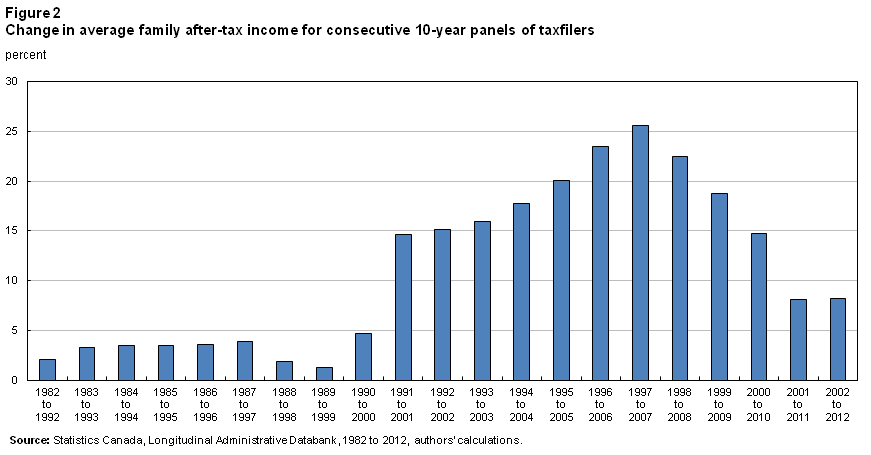
Description for Figure 2
The title of the graph is "Figure 2 Change in average family after-tax income for consecutive 10-year panels of taxfilers."
This is a column clustered chart.
There are in total 21 categories in the horizontal axis. The vertical axis starts at 0 and ends at 30 with ticks every 5 points.
There is 1 series in this graph.
The vertical axis is "percent."
The units of the horizontal axis are years from 1982 to 2002.
The title of series 1 is "Change in average family after-tax income."
The minimum value is 1.2 occurring in 1989.
The maximum value is 25.6 occurring in 1997.
| percent | |
|---|---|
| 1982 to 1992 | 2.0 |
| 1983 to 1993 | 3.2 |
| 1984 to 1994 | 3.4 |
| 1985 to 1995 | 3.5 |
| 1986 to 1996 | 3.6 |
| 1987 to 1997 | 3.9 |
| 1988 to 1998 | 1.9 |
| 1989 to 1999 | 1.2 |
| 1990 to 2000 | 4.7 |
| 1991 to 2001 | 14.7 |
| 1992 to 2002 | 15.2 |
| 1993 to 2003 | 16.0 |
| 1994 to 2004 | 17.8 |
| 1995 to 2005 | 20.0 |
| 1996 to 2006 | 23.5 |
| 1997 to 2007 | 25.6 |
| 1998 to 2008 | 22.5 |
| 1999 to 2009 | 18.7 |
| 2000 to 2010 | 14.7 |
| 2001 to 2011 | 8.1 |
| 2002 to 2012 | 8.2 |
| Source: Statistics Canada, Longitudinal Administrative Databank, 1982 to 2012, authors' calculations. | |
Of course, absolute mobility in Canada did not follow the economic cycle in unison all the time. For example, average income decreased 2.1% for taxfilers from the 1982–1987 panel, even though unemployment rate dropped from 11.2% in 1982 to 8.9% in 1987. In contrast, when the unemployment rate dropped from 11.3% in 1992 to 9.2% in 1997, average after-tax income increased by one tenth of a percentage point for taxfilers from the same panel period. Nevertheless, a simple regression analysis suggests a strong negative correlation between changes in average income and unemployment rate across the consecutive, overlapping 5-year panels of Canadian taxfilers. The regression result shows that, for each percentage-point increase in the unemployment rate, absolute mobility, measured by change in average income, would decrease by slightly more than 1.5 percentage points, other things being equal.
The second characteristic we observed is that absolute mobility for Canadian taxfilers increased over time. Figure 1 suggests that, before the 1995–2000 period, average income growth for various panels never reached 10%. Sometimes, it even fell. But starting from the 1995–2000 period, average income never declined for any 5-year panel of taxfilers, and for almost all panels of taxfilers, average income grew more than 5%; for some panels, it even grew more than 10% in 5 years. Across the ten-year panels of taxfilers, we also found that absolute mobility has increased over time. Figure 2 contains the changes of average after-tax income for the consecutive ten-year panels of taxfilers during the last thirty years. It shows that, for panels of taxfilers observed before the 1991–2001 period, the growth rate of after-tax income varied between 1.3% and 4.7%. But for taxfilers observed thereafter, the growth rate was much higher, between 8.1% and 25.6%.
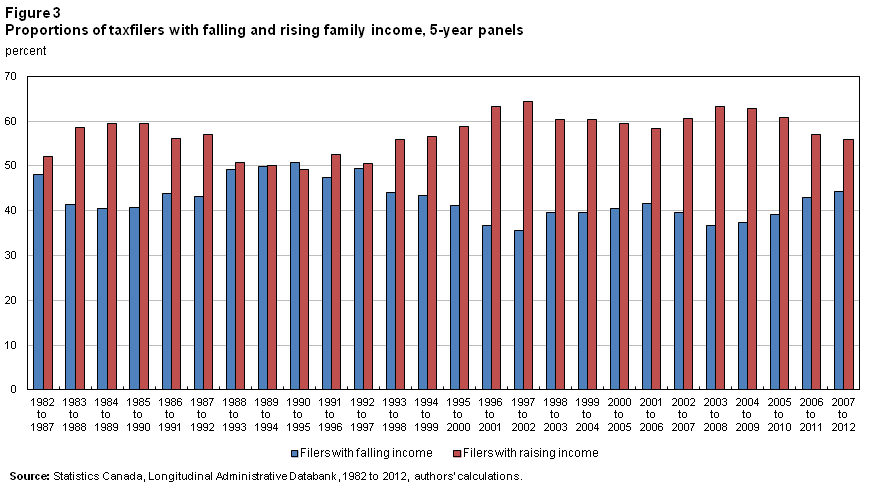
Description for Figure 3
The title of the graph is "Figure 3 Proportions of taxfilers with falling and rising family income, 5-year panels."
This is a column clustered chart.
There are in total 26 categories in the horizontal axis. The vertical axis starts at 0 and ends at 70 with ticks every 10 points.
There are 2 series in this graph.
The vertical axis is "percent."
The units of the horizontal axis are years from 1982 to 2007.
The title of series 1 is "Filers with falling income."
The minimum value is 35.5 occurring in 1997.
The maximum value is 50.8 occurring in 1990.
The title of series 2 is "Filers with raising income."
The minimum value is 49.2 occurring in 1990.
The maximum value is 64.5 occurring in 1997.
| Filers with falling income | Filers with raising income | |
|---|---|---|
| 1982 to 1987 | 48.0 | 52.0 |
| 1983 to 1988 | 41.4 | 58.6 |
| 1984 to 1989 | 40.5 | 59.5 |
| 1985 to 1990 | 40.6 | 59.4 |
| 1986 to 1991 | 43.9 | 56.1 |
| 1987 to 1992 | 43.1 | 56.9 |
| 1988 to 1993 | 49.1 | 50.9 |
| 1989 to 1994 | 49.8 | 50.2 |
| 1990 to 1995 | 50.8 | 49.2 |
| 1991 to 1996 | 47.4 | 52.6 |
| 1992 to 1997 | 49.4 | 50.6 |
| 1993 to 1998 | 44.1 | 55.9 |
| 1994 to 1999 | 43.5 | 56.5 |
| 1995 to 2000 | 41.1 | 58.9 |
| 1996 to 2001 | 36.6 | 63.4 |
| 1997 to 2002 | 35.5 | 64.5 |
| 1998 to 2003 | 39.7 | 60.3 |
| 1999 to 2004 | 39.6 | 60.4 |
| 2000 to 2005 | 40.4 | 59.6 |
| 2001 to 2006 | 41.6 | 58.4 |
| 2002 to 2007 | 39.5 | 60.5 |
| 2003 to 2008 | 36.8 | 63.2 |
| 2004 to 2009 | 37.3 | 62.7 |
| 2005 to 2010 | 39.1 | 60.9 |
| 2006 to 2011 | 43.0 | 57.0 |
| 2007 to 2012 | 44.2 | 55.8 |
| Source: Statistics Canada, Longitudinal Administrative Databank, 1982 to 2012, authors' calculations. | ||
An alternative approach to absolute mobility is to examine the distribution of taxfilers according to how their incomes changed. An individual's income may increase or decrease due to changes in labour supply, wage rates, government transfers and other factors. This approach asks questions such as how many people gained or lost income, and to what extent did the first group outnumber the second. Using this approach, we classified taxfilers from each panel into two groups: those with rising incomes and those with falling incomes. We then examined the distribution of taxfilers accordingly.Note 15 The results are presented in Figures 3 and 4.
Figure 3 shows that, before the 1995–2000 period, the proportion of taxfilers with rising income outweighed the taxfilers with falling income most of the time. But there were periods when taxfilers with falling income outweighed those with rising income, or when the two groups were more or less evenly distributed. However, starting from the 1995–2000 period, taxfilers with rising incomes always outweighed those with falling income. This also suggested that absolute income mobility became stronger during the last recent 15 years or so than before.
The distribution result for taxfilers across the 10-year panels led to the same conclusion. As can be seen from Figure 4, although the proportion of taxfilers with rising income always outweighed those with falling income across all of the 10-year panels, the gap by which taxfilers with rising income outweighed taxfilers with falling income changed. Before the 1991–2001 period, the gap was relatively small, from 3 to 8 percentage points; thereafter, the gap widened to 14 to 27 percentage points. This again indicates that absolute income mobility had become stronger during the latter 15 years or so than before.
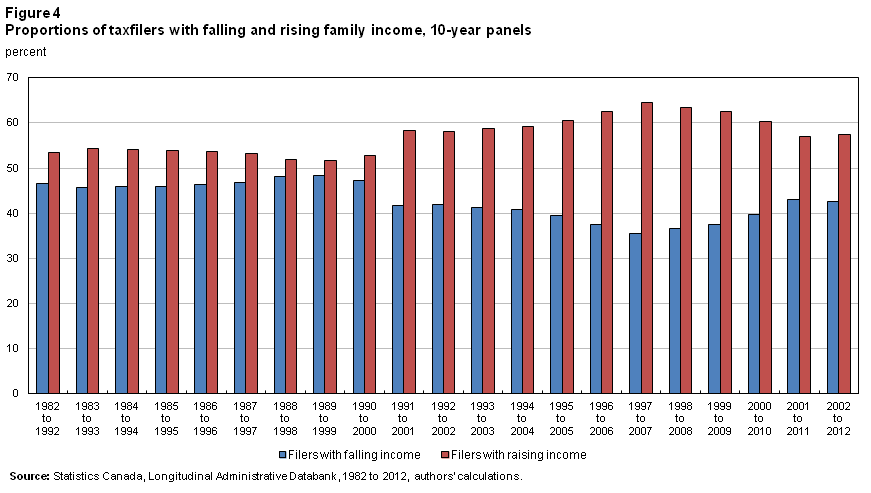
Description for Figure 4
The title of the graph is "Figure 4 Proportions of taxfilers with falling and rising family income, 10-year panels."
This is a column clustered chart.
There are in total 21 categories in the horizontal axis. The vertical axis starts at 0 and ends at 70 with ticks every 10 points.
There are 2 series in this graph.
The vertical axis is "percent."
The units of the horizontal axis are years from 1982 to 2002.
The title of series 1 is "Filers with falling income."
The minimum value is 35.5 occurring in 1997.
The maximum value is 48.4 occurring in 1989.
The title of series 2 is "Filers with raising income."
The minimum value is 51.6 occurring in 1989.
The maximum value is 64.5 occurring in 1997.
| Filers with falling income | Filers with raising income | |
|---|---|---|
| 1982 to 1992 | 46.5 | 53.5 |
| 1983 to 1993 | 45.8 | 54.2 |
| 1984 to 1994 | 45.8 | 54.2 |
| 1985 to 1995 | 46.0 | 54.0 |
| 1986 to 1996 | 46.4 | 53.6 |
| 1987 to 1997 | 46.9 | 53.1 |
| 1988 to 1998 | 48.1 | 51.9 |
| 1989 to 1999 | 48.4 | 51.6 |
| 1990 to 2000 | 47.2 | 52.8 |
| 1991 to 2001 | 41.6 | 58.4 |
| 1992 to 2002 | 41.9 | 58.1 |
| 1993 to 2003 | 41.3 | 58.7 |
| 1994 to 2004 | 40.8 | 59.2 |
| 1995 to 2005 | 39.5 | 60.5 |
| 1996 to 2006 | 37.5 | 62.5 |
| 1997 to 2007 | 35.5 | 64.5 |
| 1998 to 2008 | 36.5 | 63.5 |
| 1999 to 2009 | 37.5 | 62.5 |
| 2000 to 2010 | 39.8 | 60.2 |
| 2001 to 2011 | 43.1 | 56.9 |
| 2002 to 2012 | 42.6 | 57.4 |
| Source: Statistics Canada, Longitudinal Administrative Databank, 1982 to 2012, authors' calculations. | ||
The trends in absolute mobility held well across different age groups of taxfilers. Figures 5 and 6 present changes in average income for the 5- and 10-year panels of taxfilers by age. The two figures closely resemble Figures 1 and 2. Similar to Figure 1, Figure 5 shows that absolute income mobility closely followed the fluctuations of the economy and the labour market. For example, the growth rate of income fell sharply for all age groups due to the early-1990s recession, but it increased substantially when the economy expanded and the labour market recovered thereafter. Although Figure 5 provides some evidence that absolute income mobility became stronger during the last 15 years or so, Figure 6 demonstrates this more clearly. For instance, among panels of taxfilers observed before the 1991–2001 period, those aged 25 to 34 saw their average income grow from 21% to 25% in 10 years' time. But the same age group of taxfilers observed after that period gained from 31% to 50% in average after-tax income in 10 years' time.
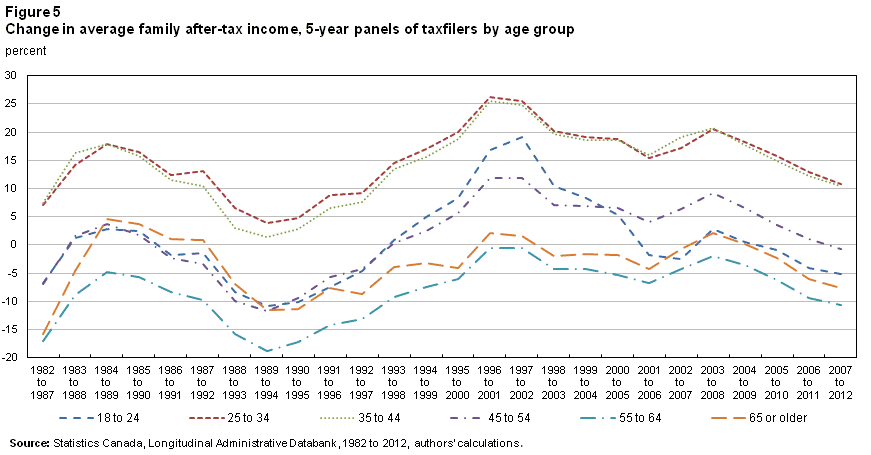
Description for Figure 5
The title of the graph is "Figure 5 Change in average family after-tax income, 5-year panels of taxfilers by age group."
This is a line chart.
There are in total 26 categories in the horizontal axis. The vertical axis starts at -20 and ends at 30 with ticks every 5 points.
There are 6 series in this graph.
The vertical axis is "percent."
The units of the horizontal axis are years from 1982 to 2007.
The title of series 1 is "18 to 24."
The minimum value is -10.8 occurring in 1989.
The maximum value is 19.2 occurring in 1997.
The title of series 2 is "25 to 34."
The minimum value is 3.8 occurring in 1989.
The maximum value is 26.3 occurring in 1996.
The title of series 3 is "35 to 44."
The minimum value is 1.3 occurring in 1989.
The maximum value is 25.6 occurring in 1996.
The title of series 4 is "45 to 54."
The minimum value is -11.8 occurring in 1989.
The maximum value is 11.9 occurring in 1996 and 1997.
The title of series 5 is "55 to 64."
The minimum value is -18.8 occurring in 1989.
The maximum value is -0.5 occurring in 1997.
The title of series 6 is "65 or older."
The minimum value is -15.9 occurring in 1982.
The maximum value is 4.6 occurring in 1984.
| 18 to 24 | 25 to 34 | 35 to 44 | 45 to 54 | 55 to 64 | 65 or older | |
|---|---|---|---|---|---|---|
| 1982 to 1987 | -6.7 | 7.1 | 7.5 | -6.9 | -17.0 | -15.9 |
| 1983 to 1988 | 1.2 | 14.2 | 16.3 | 1.6 | -8.9 | -4.7 |
| 1984 to 1989 | 2.8 | 17.9 | 17.9 | 3.7 | -4.7 | 4.6 |
| 1985 to 1990 | 2.4 | 16.4 | 15.7 | 1.7 | -5.7 | 3.7 |
| 1986 to 1991 | -1.8 | 12.4 | 11.4 | -2.3 | -8.3 | 1.0 |
| 1987 to 1992 | -1.4 | 13.1 | 10.4 | -3.3 | -9.7 | 0.8 |
| 1988 to 1993 | -8.4 | 6.5 | 3.0 | -9.9 | -15.8 | -7.0 |
| 1989 to 1994 | -10.8 | 3.8 | 1.3 | -11.8 | -18.8 | -11.6 |
| 1990 to 1995 | -10.2 | 4.8 | 2.8 | -9.4 | -17.3 | -11.3 |
| 1991 to 1996 | -7.4 | 8.9 | 6.5 | -5.7 | -14.2 | -7.6 |
| 1992 to 1997 | -4.6 | 9.2 | 7.6 | -4.3 | -13.2 | -8.8 |
| 1993 to 1998 | 0.9 | 14.5 | 13.4 | 0.3 | -9.2 | -3.9 |
| 1994 to 1999 | 5.0 | 17.0 | 15.7 | 2.5 | -7.5 | -3.2 |
| 1995 to 2000 | 8.2 | 20.1 | 18.8 | 5.6 | -6.0 | -4.1 |
| 1996 to 2001 | 16.9 | 26.3 | 25.6 | 11.9 | -0.6 | 2.2 |
| 1997 to 2002 | 19.2 | 25.6 | 24.8 | 11.9 | -0.5 | 1.5 |
| 1998 to 2003 | 10.4 | 20.1 | 19.7 | 7.0 | -4.2 | -2.0 |
| 1999 to 2004 | 8.4 | 19.2 | 18.6 | 6.8 | -4.3 | -1.7 |
| 2000 to 2005 | 5.4 | 18.8 | 18.6 | 6.5 | -5.3 | -1.8 |
| 2001 to 2006 | -1.8 | 15.4 | 15.9 | 4.0 | -6.8 | -4.3 |
| 2002 to 2007 | -2.6 | 17.1 | 19.1 | 6.4 | -4.3 | -0.8 |
| 2003 to 2008 | 2.8 | 20.6 | 20.8 | 9.3 | -1.9 | 2.1 |
| 2004 to 2009 | 0.6 | 18.3 | 17.7 | 6.6 | -3.5 | 0.1 |
| 2005 to 2010 | -0.9 | 15.8 | 14.9 | 3.5 | -6.3 | -2.4 |
| 2006 to 2011 | -4.1 | 12.8 | 12.2 | 1.0 | -9.5 | -6.0 |
| 2007 to 2012 | -5.1 | 10.7 | 10.4 | -0.6 | -10.6 | -7.7 |
| Source: Statistics Canada, Longitudinal Administrative Databank, 1982 to 2012, authors' calculations. | ||||||
While the overall pattern of absolute mobility was similar across different age groups of taxfilers, the magnitude differed. Both Figures 5 and 6 indicate that young and prime-age taxfilers had substantially higher absolute mobility than older taxfilers. For example, Figure 5 shows that Canadian taxfilers aged 25 to 34 and those 35 to 44 in 2007 saw their after-tax income rise by more than 10% in five years, while taxfilers aged 55 to 64 in 2007 saw their after-tax income drop 10% five years later. Figure 6 provides similar evidence over a longer time span. For example, in 10 years average income grew 31% for taxfilers aged 25 to 34 and 27% for those 35 to 44 in 2002. In contrast, income for taxfilers aged 55 to 64 in 2002 dropped 12% over the same period.
It is interesting to notice the changing positions of absolute mobility for two age groups of taxfilers: those aged 18 to 24 and those 45 to 54. On the one hand, for the 18-to-24 group, absolute mobility has weakened in more recent years. As Figure 5 shows, before the late 1990s, the 5-year income growth rate for the younger group had been similar to and sometimes higher than for those 45 to 54. But after the late 1990s, the income growth rate for the former fell sharply. Then, starting in the 2000‑to‑2005 period, their income growth fell below that of the older group. This declining absolute mobility for young taxfilers can also be seen in Figure 6 when the panel length is extended to 10 years. In this case, income growth for the younger group had been consistently and substantially higher than that for taxfilers aged 45 to 54. But again, since the late 1990s, the growth rate for the younger group of taxfilers fell sharply, and by the latest 10-year period, 2002 to 2012, their rate fell to the same level as that of the 45‑to‑54 group.
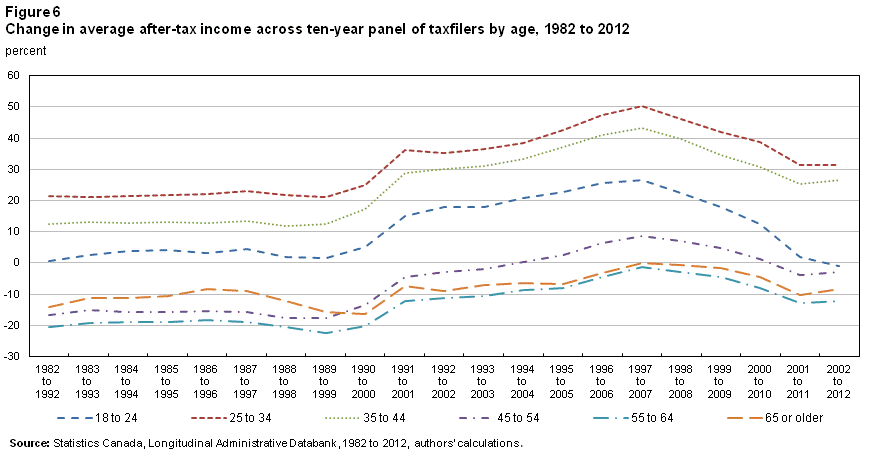
Description for Figure 6
The title of the graph is "Figure 6 Change in average after-tax income across ten-year panel of taxfilers by age, 1982 to 2012."
This is a line chart.
There are in total 21 categories in the horizontal axis. The vertical axis starts at -30 and ends at 60 with ticks every 10 points.
There are 6 series in this graph.
The vertical axis is "percent."
The units of the horizontal axis are years from 1982 to 2002.
The title of series 1 is "18 to 24."
The minimum value is -1.0 occurring in 2002.
The maximum value is 26.5 occurring in 1997.
The title of series 2 is "25 to 34."
The minimum value is 21.0 occurring in 1989.
The maximum value is 50.1 occurring in 1997.
The title of series 3 is "35 to 44."
The minimum value is 11.7 occurring in 1988.
The maximum value is 43.3 occurring in 1997.
The title of series 4 is "45 to 54."
The minimum value is -17.8 occurring in 1988 and 1989.
The maximum value is 8.5 occurring in 1997.
The title of series 5 is "55 to 64."
The minimum value is -22.5 occurring in 1989.
The maximum value is -1.5 occurring in 1997.
The title of series 6 is "65 or older."
The minimum value is -16.4 occurring in 1990.
The maximum value is 0.0 occurring in 1997.
| 18 to 24 | 25 to 34 | 35 to 44 | 45 to 54 | 55 to 64 | 65 or older | |
|---|---|---|---|---|---|---|
| 1982 to 1992 | 0.5 | 21.5 | 12.3 | -16.6 | -20.7 | -14.0 |
| 1983 to 1993 | 2.6 | 21.2 | 13.0 | -15.1 | -19.4 | -11.2 |
| 1984 to 1994 | 3.9 | 21.5 | 12.7 | -15.7 | -18.9 | -11.3 |
| 1985 to 1995 | 4.2 | 21.6 | 13.1 | -15.6 | -18.9 | -10.7 |
| 1986 to 1996 | 3.2 | 22.0 | 12.8 | -15.6 | -18.2 | -8.2 |
| 1987 to 1997 | 4.4 | 23.1 | 13.3 | -15.6 | -19.1 | -9.1 |
| 1988 to 1998 | 1.9 | 21.8 | 11.7 | -17.8 | -20.4 | -12.2 |
| 1989 to 1999 | 1.6 | 21.0 | 12.4 | -17.8 | -22.5 | -15.8 |
| 1990 to 2000 | 5.2 | 24.9 | 17.2 | -13.6 | -20.2 | -16.4 |
| 1991 to 2001 | 14.9 | 36.2 | 28.8 | -4.7 | -12.1 | -7.3 |
| 1992 to 2002 | 17.8 | 35.3 | 30.0 | -3.0 | -11.2 | -9.1 |
| 1993 to 2003 | 18.0 | 36.6 | 31.1 | -1.9 | -10.6 | -7.1 |
| 1994 to 2004 | 20.8 | 38.5 | 33.3 | 0.2 | -8.6 | -6.4 |
| 1995 to 2005 | 22.8 | 42.6 | 37.0 | 2.6 | -8.0 | -6.6 |
| 1996 to 2006 | 25.7 | 47.3 | 40.9 | 6.4 | -4.4 | -3.2 |
| 1997 to 2007 | 26.5 | 50.1 | 43.3 | 8.5 | -1.5 | 0.0 |
| 1998 to 2008 | 22.4 | 46.2 | 39.7 | 6.9 | -2.8 | -0.6 |
| 1999 to 2009 | 18.0 | 41.8 | 34.6 | 4.6 | -4.7 | -1.6 |
| 2000 to 2010 | 12.3 | 38.6 | 30.8 | 1.2 | -8.2 | -4.5 |
| 2001 to 2011 | 1.8 | 31.5 | 25.2 | -3.9 | -12.8 | -10.2 |
| 2002 to 2012 | -1.0 | 31.4 | 26.7 | -3.0 | -12.3 | -8.4 |
| Source: Statistics Canada, Longitudinal Administrative Databank, 1982 to 2012, authors' calculations. | ||||||
On the other hand, absolute income mobility has improved more recently for the 45‑to‑54 group—not only relative to the youngest group of taxfilers but also relative to taxfilers 65 and older. As mentioned before, the 5-year income growth for taxfilers aged 45 to 54 has surpassed that for taxfilers aged 18 to 24 since the early 2000s, while their 10-year income growth rate started to approach that of the younger group. The comparison was probably more striking between the 45-to-54 group and the 65-and-older group. Before the early 1990s, as shown in Figure 5, the 5-year income growth for taxfilers aged 45 to 54 had been similar to that of those 65 and older. But since the early 1990s, the 45-to-54 group's 5-year income growth rate exceeded and stayed above that of the older group. Figure 6 tells a similar story. Before the early 1990s, the 10-year income change for the 45- to 54-year-old taxfilers had been negative and worse than that for the oldest group of taxfilers. However, since the early 1990s, their 10-year income growth has been positive most of the time, and has consistently exceeded that of the oldest group of taxfilers.
We also examined the evolution of absolute mobility by the initial income quintiles of the overlapping panels of taxfilers. Again, we observed that absolute mobility followed closely the movements of the economy and the labour market. As can be seen in Figures 7a and 7b, when the economy expanded, average income grew strongly for taxfilers from the middle and bottom quintiles of the distribution—or decreased more slowly for taxfilers from the top quintile.Note 16 For example, Figure 7a shows that, to the early 1990 recession, filers from the third quintile in 1989 saw an income gain of 2% in five years by 1994. In contrast, as the economy expanded after the recession, the incomes of filers from the third quintile in 1997 gained more than 21% in five years by 2002.
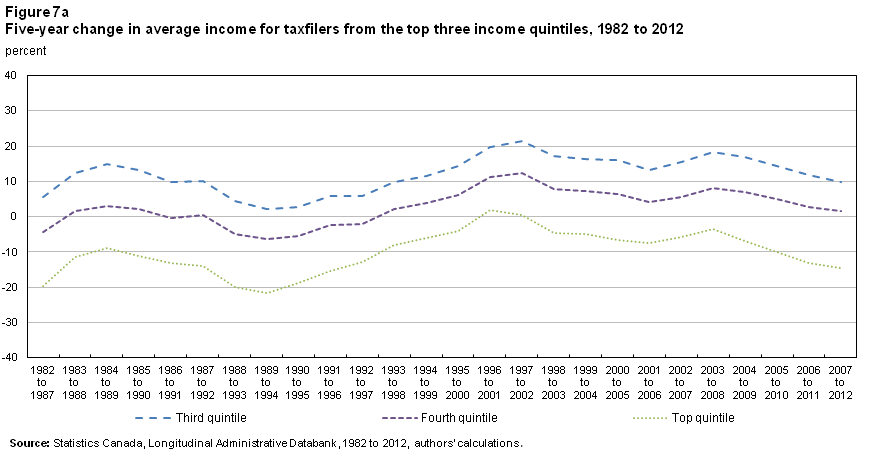
Description for Figure 7a
The title of the graph is "Figure 7a Five-year change in average income for taxfilers from the top three income quintiles, 1982 to 2012."
This is a line chart.
There are in total 26 categories in the horizontal axis. The vertical axis starts at -40 and ends at 40 with ticks every 10 points.
There are 3 series in this graph.
The vertical axis is "percent."
The units of the horizontal axis are years from 1982 to 2007.
The title of series 1 is " Third quintile ."
The minimum value is 2.2 occurring in 1989.
The maximum value is 21.5 occurring in 1997.
The title of series 2 is "Fourth quintile ."
The minimum value is -6.2 occurring in 1989.
The maximum value is 12.5 occurring in 1997.
The title of series 3 is "Top quintile."
The minimum value is -21.7 occurring in 1989.
The maximum value is 1.9 occurring in 1996.
| Third quintile | Fourth quintile | Top quintile | |
|---|---|---|---|
| 1982 to 1987 | 5.6 | -4.3 | -19.6 |
| 1983 to 1988 | 12.3 | 1.5 | -11.6 |
| 1984 to 1989 | 14.9 | 3.0 | -8.9 |
| 1985 to 1990 | 13.4 | 2.3 | -11.2 |
| 1986 to 1991 | 9.8 | -0.3 | -13.0 |
| 1987 to 1992 | 10.0 | 0.4 | -14.0 |
| 1988 to 1993 | 4.4 | -4.9 | -20.0 |
| 1989 to 1994 | 2.2 | -6.2 | -21.7 |
| 1990 to 1995 | 2.7 | -5.5 | -18.7 |
| 1991 to 1996 | 5.9 | -2.2 | -15.3 |
| 1992 to 1997 | 5.7 | -2.0 | -12.8 |
| 1993 to 1998 | 9.9 | 2.1 | -8.1 |
| 1994 to 1999 | 11.5 | 3.8 | -6.0 |
| 1995 to 2000 | 14.3 | 6.1 | -4.0 |
| 1996 to 2001 | 19.9 | 11.2 | 1.9 |
| 1997 to 2002 | 21.5 | 12.5 | 0.4 |
| 1998 to 2003 | 17.1 | 7.9 | -4.5 |
| 1999 to 2004 | 16.5 | 7.2 | -4.8 |
| 2000 to 2005 | 16.1 | 6.5 | -6.5 |
| 2001 to 2006 | 13.2 | 4.2 | -7.5 |
| 2002 to 2007 | 15.5 | 5.6 | -5.9 |
| 2003 to 2008 | 18.2 | 8.2 | -3.4 |
| 2004 to 2009 | 16.9 | 7.0 | -6.9 |
| 2005 to 2010 | 14.3 | 5.0 | -9.9 |
| 2006 to 2011 | 11.7 | 2.9 | -13.0 |
| 2007 to 2012 | 9.7 | 1.5 | -14.5 |
| Source: Statistics Canada, Longitudinal Administrative Databank, 1982 to 2012, authors' calculations. | |||
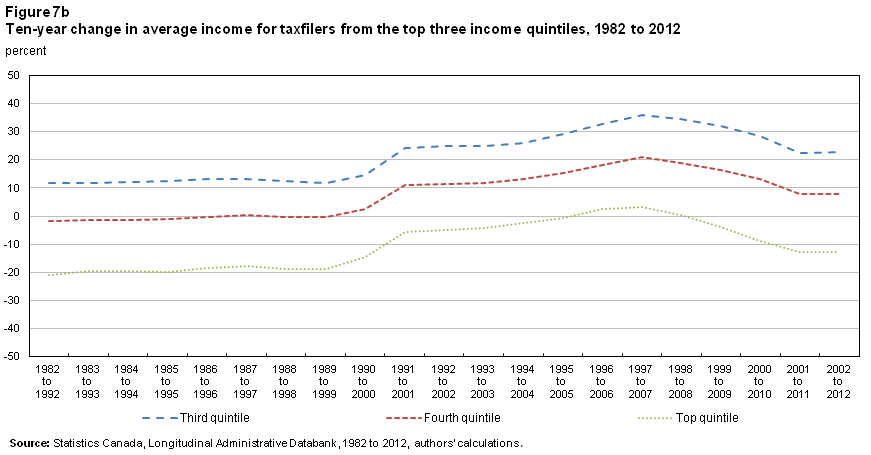
Description for Figure 7b
The title of the graph is "Figure 7b Ten-year change in average income for taxfilers from the top three income quintiles, 1982 to 2012."
This is a line chart.
There are in total 21 categories in the horizontal axis. The vertical axis starts at -50 and ends at 50 with ticks every 10 points.
There are 3 series in this graph.
The vertical axis is "percent."
The units of the horizontal axis are years from 1982 to 2002.
The title of series 1 is "Third quintile."
The minimum value is 11.8 occurring in 1982.
The maximum value is 36.2 occurring in 1997.
The title of series 2 is "Fourth quintile."
The minimum value is -1.6 occurring in 1982.
The maximum value is 21.0 occurring in 1997.
The title of series 3 is "Top quintile."
The minimum value is -20.8 occurring in 1982.
The maximum value is 3.3 occurring in 1997.
| Third quintile | Fourth quintile | Top quintile | |
|---|---|---|---|
| 1982 to 1992 | 11.8 | -1.6 | -20.8 |
| 1983 to 1993 | 11.9 | -1.5 | -19.7 |
| 1984 to 1994 | 12.1 | -1.5 | -19.6 |
| 1985 to 1995 | 12.6 | -1.1 | -19.8 |
| 1986 to 1996 | 13.0 | -0.3 | -18.5 |
| 1987 to 1997 | 13.2 | 0.4 | -17.6 |
| 1988 to 1998 | 12.6 | -0.3 | -18.9 |
| 1989 to 1999 | 11.9 | -0.5 | -18.8 |
| 1990 to 2000 | 14.8 | 2.6 | -14.7 |
| 1991 to 2001 | 24.2 | 10.9 | -5.6 |
| 1992 to 2002 | 25.0 | 11.4 | -4.8 |
| 1993 to 2003 | 25.0 | 11.8 | -4.4 |
| 1994 to 2004 | 26.0 | 13.1 | -2.3 |
| 1995 to 2005 | 29.2 | 15.3 | -0.8 |
| 1996 to 2006 | 32.6 | 18.1 | 2.5 |
| 1997 to 2007 | 36.2 | 21.0 | 3.3 |
| 1998 to 2008 | 34.6 | 18.9 | 0.3 |
| 1999 to 2009 | 32.0 | 16.5 | -3.9 |
| 2000 to 2010 | 28.5 | 13.3 | -8.8 |
| 2001 to 2011 | 22.3 | 8.0 | -12.8 |
| 2002 to 2012 | 22.7 | 7.7 | -12.9 |
| Source: Statistics Canada, Longitudinal Administrative Databank, 1982 to 2012, authors' calculations. | |||
Absolute mobility rose recently for filers from the third, fourth and top quintiles. Figure 7a shows that average income grew faster for filers in the middle and top quintiles in years 2000 and thereafter than before. For example, before 2000, the five-year income growth rate varied between 2% and 15% for filers from the third quintile, while in year 2000 and thereafter, filers from the third quintile saw their average income grew between 8% and 22%. Absolute income mobility also shifted up in the past fifteen years or so for filers from the top three quintiles when we expanded the panel length to ten years and this can be seen clearly from Figure 7b.
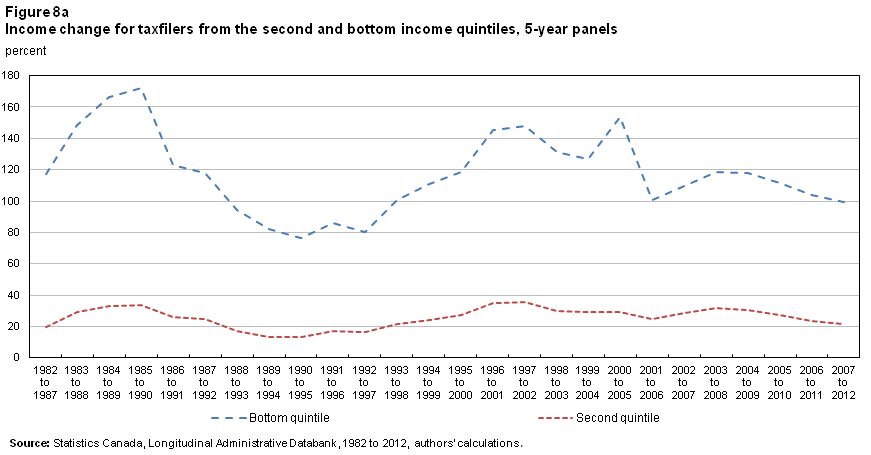
Description for Figure 8a
The title of the graph is "Figure 8a Income change for taxfilers from the second and bottom income quintiles, 5-year panels."
This is a line chart.
There are in total 26 categories in the horizontal axis. The vertical axis starts at 0 and ends at 180 with ticks every 20 points.
There are 2 series in this graph.
The vertical axis is "percent."
The units of the horizontal axis are years from 1982 to 2007.
The title of series 1 is "Bottom quintile."
The minimum value is 76.6 occurring in 1990.
The maximum value is 172.1 occurring in 1985.
The title of series 2 is "Second quintile."
The minimum value is 13.1 occurring in 1990.
The maximum value is 35.4 occurring in 1997.
| Bottom quintile | Second quintile | |
|---|---|---|
| 1982 to 1987 | 117.4 | 19.5 |
| 1983 to 1988 | 148.5 | 29.3 |
| 1984 to 1989 | 166.3 | 33.2 |
| 1985 to 1990 | 172.1 | 33.4 |
| 1986 to 1991 | 123.1 | 26.2 |
| 1987 to 1992 | 117.9 | 25.0 |
| 1988 to 1993 | 94.1 | 17.0 |
| 1989 to 1994 | 82.2 | 13.4 |
| 1990 to 1995 | 76.6 | 13.1 |
| 1991 to 1996 | 85.8 | 17.3 |
| 1992 to 1997 | 80.4 | 16.3 |
| 1993 to 1998 | 100.8 | 21.4 |
| 1994 to 1999 | 111.0 | 23.8 |
| 1995 to 2000 | 118.8 | 27.1 |
| 1996 to 2001 | 145.6 | 34.6 |
| 1997 to 2002 | 147.8 | 35.4 |
| 1998 to 2003 | 131.2 | 29.5 |
| 1999 to 2004 | 126.5 | 29.0 |
| 2000 to 2005 | 153.7 | 29.4 |
| 2001 to 2006 | 100.7 | 24.9 |
| 2002 to 2007 | 109.6 | 28.4 |
| 2003 to 2008 | 118.7 | 31.7 |
| 2004 to 2009 | 118.0 | 30.4 |
| 2005 to 2010 | 111.6 | 27.0 |
| 2006 to 2011 | 103.8 | 23.7 |
| 2007 to 2012 | 99.6 | 21.2 |
| Source: Statistics Canada, Longitudinal Administrative Databank, 1982 to 2012, authors' calculations. | ||
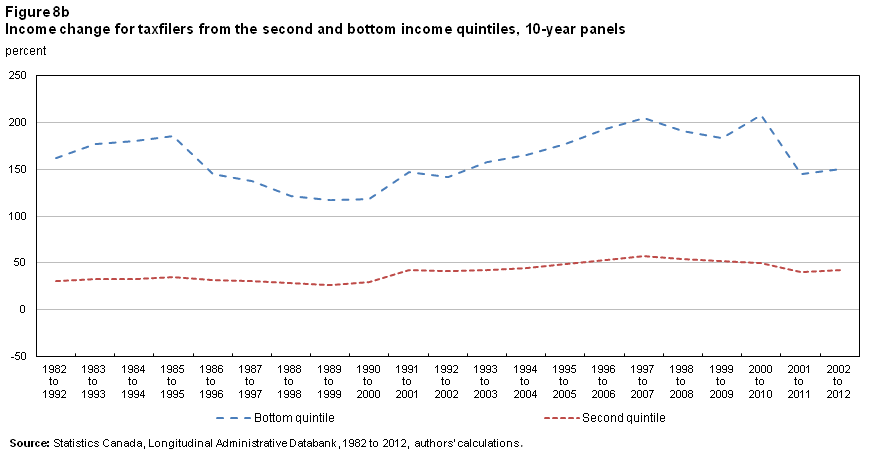
Description for Figure 8b
The title of the graph is "Figure 8b Income change for taxfilers from the second and bottom income quintiles, 10-year panels."
This is a line chart.
There are in total 21 categories in the horizontal axis. The vertical axis starts at -50 and ends at 250 with ticks every 50 points.
There are 2 series in this graph.
The vertical axis is "percent."
The units of the horizontal axis are years from 1982 to 2002.
The title of series 1 is "Bottom quintile."
The minimum value is 116.7 occurring in 1989.
The maximum value is 208.0 occurring in 2000.
The title of series 2 is "Second quintile."
The minimum value is 26.4 occurring in 1989.
The maximum value is 57.6 occurring in 1997.
| Bottom quintile | Second quintile | |
|---|---|---|
| 1982 to 1992 | 161.8 | 30.7 |
| 1983 to 1993 | 176.5 | 32.3 |
| 1984 to 1994 | 180.6 | 32.9 |
| 1985 to 1995 | 185.4 | 34.4 |
| 1986 to 1996 | 145.2 | 32.1 |
| 1987 to 1997 | 137.2 | 30.9 |
| 1988 to 1998 | 121.1 | 28.4 |
| 1989 to 1999 | 116.7 | 26.4 |
| 1990 to 2000 | 117.9 | 29.5 |
| 1991 to 2001 | 146.5 | 42.1 |
| 1992 to 2002 | 141.5 | 41.8 |
| 1993 to 2003 | 157.9 | 42.9 |
| 1994 to 2004 | 165.5 | 44.5 |
| 1995 to 2005 | 176.8 | 48.7 |
| 1996 to 2006 | 193.4 | 53.4 |
| 1997 to 2007 | 204.8 | 57.6 |
| 1998 to 2008 | 191.1 | 54.6 |
| 1999 to 2009 | 182.9 | 52.0 |
| 2000 to 2010 | 208.0 | 49.4 |
| 2001 to 2011 | 144.8 | 40.7 |
| 2002 to 2012 | 150.3 | 42.1 |
| Source: Statistics Canada, Longitudinal Administrative Databank, 1982 to 2012, authors' calculations. | ||
But the results for taxfilers from the bottom and the second quintiles were mixed. Across the 5-year panels (Figure 8a), the income growth rate followed a downward trend for taxfilers from the bottom quintile. Although the growth rate was higher in the last 15 years than in the period around the early-1990s recession, it never surpassed the historical high reached in the late 1980s. For taxfilers from the second quintile, the 5-year income growth rate varied around 30% in the 1980s and during the last 15 years or so and there was only a short-term upward movement following the early-1990s recession. In contrast, across the 10-year panels (Figure 8b), clearer upward movements in income growth can be seen for taxfilers from the bottom and second income quintiles. For example, from the 1982-to-1992 period to the 1990-to-2000 period, the 10-year income growth rate varied from 117% to 185% for taxfilers in the two bottom quintiles. But thereafter, their 10-year income growth rate shifted up to between 142% and 208%.
In this section, we examined the absolute income mobility for consecutive 5- and 10-year panels of taxfilers over the past 30 years. The consecutiveness of data panels helps to ensure that our conclusions are not influenced by arbitrary choices of starting and ending years of the study period. We found that absolute mobility among Canadian taxfilers was largely driven by the movements of the overall economy, and that absolute mobility had become stronger in the last 15 years than in the first 15 years. This higher absolute mobility occurred for prime-age taxfilers and for taxfilers from the middle and top income quintiles. But there was also evidence suggesting that taxfilers aged 18 to 24 and taxfilers from the bottom quintile did not make the income gains other groups made in recent years compared with the 1980s. Moreover, while absolute mobility was generally higher in the last 15 years than in the first 15, it appeared to lose some momentum after the 2008 financial crisis.
4. Trends in relative income mobility
Evidence on absolute mobility in the last section suggested that Canadian taxfilers, on average were doing well in the last 15 years or so. But a person did well in his own right does not necessarily mean that he was able to keep up with or doing better than his peers. To see this aspect of economic well-being, we need to examine the relative income mobility. Since relative mobility depends on both the income of the person in question and incomes of his peers, it is also directly tied with income inequality. Hence, studying the evolution of relative mobility also helps us to better understand income inequality in Canada.
In this section, we first present results for overall relative income mobility. Next, we decompose the overall relative mobility into two components—upward mobility and downward mobility. These are then followed by presentations of relative mobility for different age and income groups of taxfilers. Because our results from the 5- and 10-year panels of taxfilers led to the same qualitative conclusions, in the presentation, we shall focus only on results from the 5-year panels.
Trends in overall relative mobility
We employed several mobility indexes to measure the aggregate relative mobility among Canadian taxfilers. All of them were based on the income transition matrices. A transition matrix indicates how the income position of a person changes between two points of time. The transition matrix approach is quite flexible. Individuals can be classified into deciles, quintiles, quartiles, and so on over different lengths of transition period. We conducted our analysis using both the quintile and decile transition matrices and examined the transition probabilities over 5- and 10-year periods. The conclusions were essentially the same.
An example of the transition matrix is given in Table 1, which shows the estimated transition probabilities for the 2007-to-2012 panel of taxfilers. As an illustration, consider the third row of the matrix. The 10 elements in this row show the 5-year transition probabilities for taxfilers who were in the third decile in 2007. The third element from the left in the third row, 36.3%, shows the proportion of taxfilers from the third decile in the 2007 distribution who stayed in the same decile in 2012. The sum of the other 9 elements from the third row tells the proportion of taxfilers who moved to a different decile 5 years later. The two proportions add up to 1. The former measures the immobility; the latter measures total relative mobility for taxfilers who were in the third decile in 2007.
Table 1
Decile income transition matrix for the 2007-to-2012 panel of taxfilers
| 2007 decile | 2012 decile | Total mobility statistics | |||||||||||
|---|---|---|---|---|---|---|---|---|---|---|---|---|---|
| 1st | 2nd | 3rd | 4th | 5th | 6th | 7th | 8th | 9th | 10th | Immobility | Upward | Downward | |
| percentage | percentage | ||||||||||||
| 1st | 39.7 | 22.9 | 11.2 | 7.6 | 5.4 | 4.0 | 3.1 | 2.5 | 2.0 | 1.5 | 39.7 | 60.3 | 0.0 |
| 2nd | 13.5 | 39.4 | 18.5 | 10.0 | 6.2 | 4.4 | 3.1 | 2.2 | 1.6 | 1.0 | 39.4 | 47.0 | 13.5 |
| 3rd | 6.4 | 14.9 | 36.3 | 16.9 | 9.7 | 6.1 | 4.1 | 2.8 | 1.8 | 1.0 | 36.3 | 42.4 | 21.4 |
| 4th | 4.5 | 7.2 | 17.5 | 27.6 | 17.5 | 10.7 | 6.8 | 4.3 | 2.6 | 1.3 | 27.6 | 43.2 | 29.2 |
| 5th | 3.1 | 4.4 | 8.2 | 17.0 | 25.6 | 17.6 | 11.3 | 6.9 | 4.0 | 1.8 | 25.6 | 41.6 | 32.7 |
| 6th | 2.3 | 3.0 | 5.1 | 9.0 | 16.9 | 24.3 | 18.3 | 11.7 | 6.5 | 2.7 | 24.3 | 39.3 | 36.4 |
| 7th | 1.8 | 2.1 | 3.4 | 5.9 | 9.5 | 16.9 | 24.3 | 19.6 | 11.8 | 4.6 | 24.3 | 36.0 | 39.7 |
| 8th | 1.4 | 1.6 | 2.3 | 4.0 | 6.4 | 9.9 | 17.2 | 26.3 | 22.0 | 8.8 | 26.3 | 30.9 | 42.8 |
| 9th | 1.2 | 1.2 | 1.6 | 2.7 | 4.1 | 6.4 | 10.1 | 18.1 | 32.5 | 22.1 | 32.5 | 22.1 | 45.4 |
| 10th | 1.2 | 0.9 | 1.1 | 1.6 | 2.4 | 3.4 | 5.3 | 8.6 | 18.2 | 57.4 | 57.4 | 0.0 | 42.6 |
| Average | 33.3 | 36.3 | 30.4 | ||||||||||
| Source: Statistics Canada, Longitudinal Administrative Databank 2007 and 2012, authors' calculations. | |||||||||||||
Total relative mobility can be further decomposed into upward and downward mobility. Upward mobility shows the proportion of taxfilers who move up along the distribution ladder. For taxfilers who were in the third decile in 2007, upward mobility indicates how many of them moved to the fourth or higher deciles in 2012. Downward mobility shows the proportion of taxfilers who move down the distribution ladder. For taxfilers who were in the third decile in 2007, downward mobility indicates how many of them moved to the second or the first deciles in 2012.Note 17 Similar interpretation can be made for other rows of taxfilers in the table. When we average the immobility, total mobility, upward mobility and downward mobility for taxfilers from all rows of the transition matrix, we obtain the average immobility, average mobility, average upward mobility and average downward mobility for the whole panel of taxfilers over the observation period.
Figures 9, 10, and 11 illustrate the evolution of total relative mobility from a number of different angles. They all indicate that relative income mobility followed a downward trend over the last 30 years for Canadian taxfilers. Figure 9 presents total relative mobility for consecutive 5-year panels of taxfilers. Although the majority of Canadian taxfilers moved from one income decile to another during a given 5-year period, the proportion of movers declined slowly, suggesting that total relative mobility weakened over time. Among the first 10 panels of taxfilers observed between the 1982-to-1987 and 1992-to-1997 periods, 72% to 75% changed income deciles in 5 years. But the proportion fell slowly for consecutive panels of taxfilers after the 1992-to-1997 period. For example, total relative mobility varied between 69% and 71% for taxfilers from the next nine panels and for taxfilers from the seven panels thereafter, the proportion fell further to between 67% and 69%.
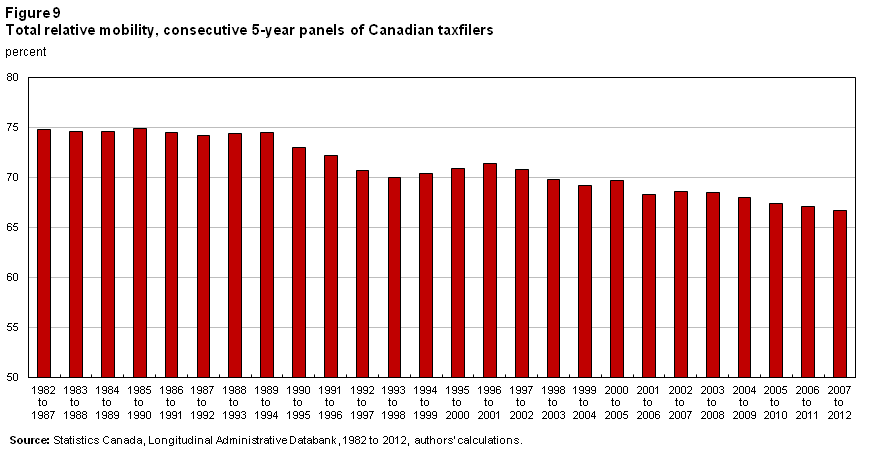
Description for Figure 9
The title of the graph is "Figure 9 Total relative mobility, consecutive 5-year panels of Canadian taxfilers."
This is a column clustered chart.
There are in total 26 categories in the horizontal axis. The vertical axis starts at 50 and ends at 80 with ticks every 5 points.
There is 1 series in this graph.
The vertical axis is "percent."
The units of the horizontal axis are years from 1982 to 2007.
The title of series 1 is "Total relative mobility."
The minimum value is 66.7 occurring in 2007.
The maximum value is 74.9 occurring in 1985.
| percent | |
|---|---|
| 1982 to 1987 | 74.8 |
| 1983 to 1988 | 74.6 |
| 1984 to 1989 | 74.6 |
| 1985 to 1990 | 74.9 |
| 1986 to 1991 | 74.5 |
| 1987 to 1992 | 74.2 |
| 1988 to 1993 | 74.4 |
| 1989 to 1994 | 74.5 |
| 1990 to 1995 | 73.0 |
| 1991 to 1996 | 72.2 |
| 1992 to 1997 | 70.7 |
| 1993 to 1998 | 70.0 |
| 1994 to 1999 | 70.4 |
| 1995 to 2000 | 70.9 |
| 1996 to 2001 | 71.4 |
| 1997 to 2002 | 70.8 |
| 1998 to 2003 | 69.8 |
| 1999 to 2004 | 69.2 |
| 2000 to 2005 | 69.7 |
| 2001 to 2006 | 68.3 |
| 2002 to 2007 | 68.6 |
| 2003 to 2008 | 68.5 |
| 2004 to 2009 | 68.0 |
| 2005 to 2010 | 67.4 |
| 2006 to 2011 | 67.1 |
| 2007 to 2012 | 66.7 |
| Source: Statistics Canada, Longitudinal Administrative Databank, 1982 to 2012, authors' calculations. | |
Declining relative mobility can also be seen through the per capita decile mobility index shown in Figure 10. The per capita mobility index shows the average number of deciles a person moves over a given period of time. In our example of the transition matrix, if a taxfiler was in the bottom (first) decile in 2007 and moved to the third decile in 2012, then we would say that they moved up two deciles in 5 years. If another taxfiler was found in the seventh decile in 2007 and moved to the third decile in 2012, then we would say they moved down four deciles. Thus, in total, the two taxfilers moved six deciles, and their average number of deciles moved was three. This per capita index measures income mobility from a different perspective than the total relative mobility index shown in Figure 9. The total relative mobility index shows how many people changed income positions while the per capita decile mobility index tells us how far they moved on average.
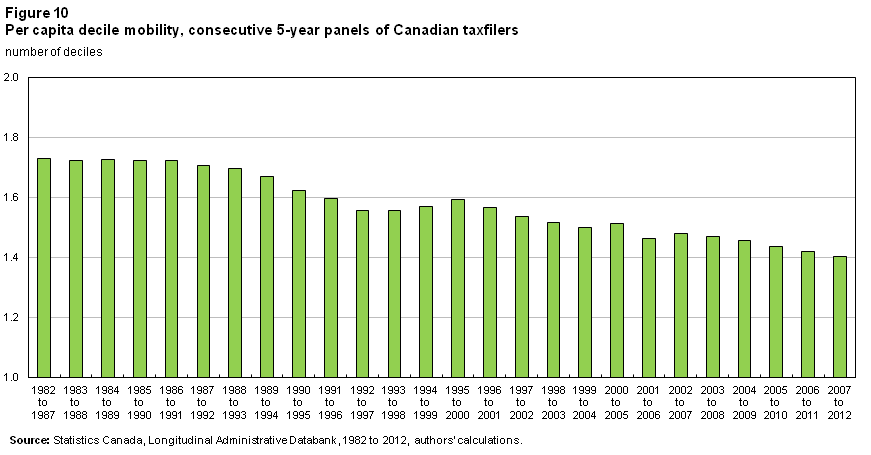
Description for Figure 10
The title of the graph is "Figure 10 Per capita decile mobility, consecutive 5-year panels of Canadian taxfilers."
This is a column clustered chart.
There are in total 26 categories in the horizontal axis. The vertical axis starts at 1 and ends at 2 with ticks every 0.2 points.
There is 1 series in this graph.
The vertical axis is "number of deciles."
The units of the horizontal axis are years from 1982 to 2007.
The title of series 1 is "number of deciles."
The minimum value is 1.4 occurring in 2005, 2006 and 2007.
The maximum value is 1.7 occurring in 1982, 1983, 1984, 1985, 1986, 1987, 1988 and 1989.
| number of deciles | |
|---|---|
| 1982 | 1.7 |
| 1983 | 1.7 |
| 1984 | 1.7 |
| 1985 | 1.7 |
| 1986 | 1.7 |
| 1987 | 1.7 |
| 1988 | 1.7 |
| 1989 | 1.7 |
| 1990 | 1.6 |
| 1991 | 1.6 |
| 1992 | 1.6 |
| 1993 | 1.6 |
| 1994 | 1.6 |
| 1995 | 1.6 |
| 1996 | 1.6 |
| 1997 | 1.5 |
| 1998 | 1.5 |
| 1999 | 1.5 |
| 2000 | 1.5 |
| 2001 | 1.5 |
| 2002 | 1.5 |
| 2003 | 1.5 |
| 2004 | 1.5 |
| 2005 | 1.4 |
| 2006 | 1.4 |
| 2007 | 1.4 |
| Source: Statistics Canada, Longitudinal Administrative Databank, 1982 to 2012, authors' calculations. | |
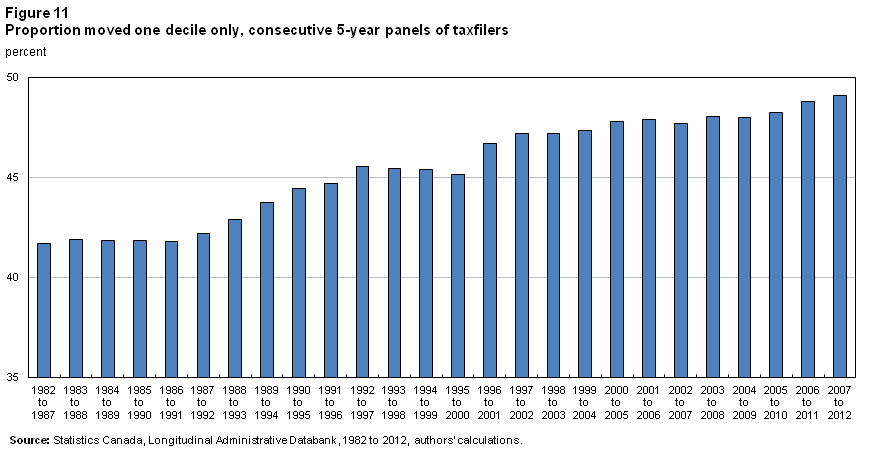
Description for Figure 11
The title of the graph is "Figure 11 Proportion moved one decile only, consecutive 5-year panels of taxfilers."
This is a column clustered chart.
There are in total 26 categories in the horizontal axis. The vertical axis starts at 35 and ends at 50 with ticks every 5 points.
There is 1 series in this graph.
The vertical axis is "percent."
The units of the horizontal axis are years from 1982 to 2007.
The title of series 1 is "percent moved one decile only."
The minimum value is 41.7 occurring in 1982.
The maximum value is 49.1 occurring in 2007.
| percent | |
|---|---|
| 1982 to 1987 | 41.7 |
| 1983 to 1988 | 41.9 |
| 1984 to 1989 | 41.9 |
| 1985 to 1990 | 41.9 |
| 1986 to 1991 | 41.8 |
| 1987 to 1992 | 42.2 |
| 1988 to 1993 | 42.9 |
| 1989 to 1994 | 43.7 |
| 1990 to 1995 | 44.5 |
| 1991 to 1996 | 44.7 |
| 1992 to 1997 | 45.6 |
| 1993 to 1998 | 45.5 |
| 1994 to 1999 | 45.4 |
| 1995 to 2000 | 45.2 |
| 1996 to 2001 | 46.7 |
| 1997 to 2002 | 47.2 |
| 1998 to 2003 | 47.2 |
| 1999 to 2004 | 47.4 |
| 2000 to 2005 | 47.8 |
| 2001 to 2006 | 47.9 |
| 2002 to 2007 | 47.7 |
| 2003 to 2008 | 48.0 |
| 2004 to 2009 | 48.0 |
| 2005 to 2010 | 48.2 |
| 2006 to 2011 | 48.8 |
| 2007 to 2012 | 49.1 |
| Source: Statistics Canada, Longitudinal Administrative Databank, 1982 to 2012, authors' calculations. | |
In terms of the distance moved, our results again show that relative income mobility dropped over time for Canadian taxfilers. Figure 10 indicates that, taxfilers from the first eight panels, observed from the 1982-to-1987 period to the 1989-to-1994 period, moved on average 1.7 deciles. The index fell to 1.6 deciles for the next seven panels of taxfilers, observed from the 1990-to-1995 period to the 1996-to-2001 period. The index continued to fall to 1.5 for the next eight panels of taxfilers observed from the 1997-to-2002 period to the 2004-to-2009 period. Finally, the last three panels of taxfilers moved on average only 1.4 deciles in 5 years.
We can also see the weakening relative income mobility by looking at the proportion of individuals who moved a very short distance. This is a 'conditional relative mobility' index that tells us, among those whose income position changed at all over time, how many moved only a short distance. Figure 11 shows the proportion of taxfilers who moved one decile only among those who did move from one decile to another in the given 5-year periods. Clearly, an increasing proportion of Canadian taxfilers moved by only a short distance. Among the first six panels of taxfilers observed from the 1982-to-1987 period to the 1987-to-1992 period, about 43% moved by one decile. For taxfilers from the next eight panels, observed from the 1988-to-1993 period to the 1995-to-2000 period, the proportion varied from 43% to 45%. The proportion continued to increase slowly thereafter. By the 2007-to-2012 period, among taxfilers who moved at all in the given 5-year period, more than 49% moved by only one decile.
Upward mobility, downward mobility and immobility
Because total relative mobility is the sum of the upward and downward mobility, the first question to ask after observing the declining total relative mobility is what is behind the declining trend in total relative mobility? Was it a result of declining upward mobility, declining downward mobility, or something else? The answer is that the drop in upward mobility was the main factor behind the declining total relative mobility from the late 1980s to the mid 1990s; however, during the last 15 years, the decline in downward mobility has contributed more.
Figure 12 illustrates the above observation. For the early panels of taxfilers, including taxfilers observed from the 1982-to-1987 period to the 1990-to-1995 period, the high total relative mobility, shown in Figure 9, was associated with high upward mobility. During these 15 years, between 43% and 45% of taxfilers consistently moved from a lower decile to a higher decile within the 5-year observation periods. At the same time, less than 32% of taxfilers moved from a higher decile to a lower decile. For the next seven panels of taxfilers observed from the 1990-to-1995 period to the 1996-to-2001 period, the upward mobility dropped, from more than 43%, for the 1990-to-1995 panel to 38%, for the 1996-to-2001 panel. On the other hand, the downward mobility increased from 30%, for the 1992-to-1997 panel, to 34%, for the 1996-to-2001 panel. But the continuing decline in total relative mobility over the last 15 years, albeit at a slower pace, was more likely the result of the drop in the downward mobility. For panels of taxfilers observed after the 2000-to-2005 period, the upward mobility remained stable (around 36%). However, a consistently lower proportion of taxfilers moved down the income ladder. For instance, at the peak of the 1996-to-2001 period, 34% of taxfilers moved from a higher decile to a lower one; however, by the 2005-to-2012 period, the downward mobility fell to 30%.
Figure 12 also shows the total immobility index. It measures the proportion of taxfilers who stayed in the same income position over time. Total immobility is the mirror image of total mobility, and these two indexes sum to one. Therefore, it is natural to observe increasing immobility among Canadian taxfilers when their total relative mobility followed a downward trend. But the decomposition provides an additional, interesting observation. In the 1980s and the early 1990s, both the upward and the downward mobility far outweighed the immobility. But, from then on, the immobility index started to increase, and, from the 2004-to-2009 period, the immobility index exceeded the downward mobility index.
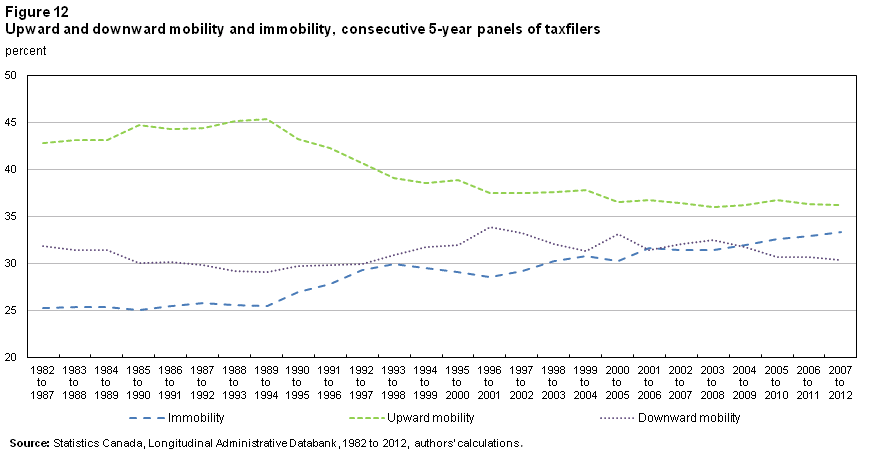
Description for Figure 12
The title of the graph is "Figure 12 Upward and downward mobility and immobility, consecutive 5-year panels of taxfilers."
This is a line chart.
There are in total 26 categories in the horizontal axis. The vertical axis starts at 20 and ends at 50 with ticks every 5 points.
There are 3 series in this graph.
The vertical axis is "percent."
The units of the horizontal axis are years from 1982 to 2007.
The title of series 1 is "Immobility."
The minimum value is 25.1 occurring in 1985.
The maximum value is 33.3 occurring in 2007.
The title of series 2 is "Upward mobility."
The minimum value is 36.0 occurring in 2003.
The maximum value is 45.4 occurring in 1989.
The title of series 3 is "Downward mobility."
The minimum value is 29.1 occurring in 1989.
The maximum value is 33.9 occurring in 1996.
| Immobility | Upward mobility | Downward mobility | |
|---|---|---|---|
| 1982 to 1987 | 25.2 | 42.9 | 31.9 |
| 1983 to 1988 | 25.4 | 43.1 | 31.5 |
| 1984 to 1989 | 25.4 | 43.1 | 31.5 |
| 1985 to 1990 | 25.1 | 44.8 | 30.1 |
| 1986 to 1991 | 25.5 | 44.4 | 30.2 |
| 1987 to 1992 | 25.8 | 44.4 | 29.8 |
| 1988 to 1993 | 25.6 | 45.1 | 29.2 |
| 1989 to 1994 | 25.5 | 45.4 | 29.1 |
| 1990 to 1995 | 27.0 | 43.3 | 29.7 |
| 1991 to 1996 | 27.8 | 42.3 | 29.9 |
| 1992 to 1997 | 29.3 | 40.7 | 29.9 |
| 1993 to 1998 | 30.0 | 39.1 | 30.9 |
| 1994 to 1999 | 29.6 | 38.6 | 31.8 |
| 1995 to 2000 | 29.1 | 38.9 | 31.9 |
| 1996 to 2001 | 28.6 | 37.5 | 33.9 |
| 1997 to 2002 | 29.2 | 37.5 | 33.3 |
| 1998 to 2003 | 30.2 | 37.7 | 32.1 |
| 1999 to 2004 | 30.8 | 37.9 | 31.3 |
| 2000 to 2005 | 30.3 | 36.5 | 33.2 |
| 2001 to 2006 | 31.7 | 36.8 | 31.5 |
| 2002 to 2007 | 31.4 | 36.4 | 32.1 |
| 2003 to 2008 | 31.5 | 36.0 | 32.5 |
| 2004 to 2009 | 32.0 | 36.2 | 31.8 |
| 2005 to 2010 | 32.6 | 36.7 | 30.7 |
| 2006 to 2011 | 32.9 | 36.4 | 30.7 |
| 2007 to 2012 | 33.3 | 36.3 | 30.4 |
| Source: Statistics Canada, Longitudinal Administrative Databank, 1982 to 2012, authors' calculations. | |||
Hence, the long-term decline in total relative mobility among Canadian taxfilers in the past thirty years was driven by movements in both the upward and the downward mobility. The decline in total relative mobility in the 1990s was mainly the result of a drop in the upward mobility, while the declining downward mobility seemed to be the main factor for the continuing drop in total relative mobility since the 2002-to-2007 period.
Relative mobility across age and income groups
Total relative mobility dropped more significantly for the older groups of taxfilers than for their younger counterparts. Figure 13 highlights the evolution of the 5-year relative mobility for consecutive 5-year panels of taxfilers, classified by age. Relative mobility dropped only slightly for younger taxfilers. For example, during the 1980s and the early 1990s, about 82% of taxfilers aged 18 to 24 moved from one income decile to another in a given 5-year period. This dropped to 80% during the last 15 years or so. Similarly, for taxfilers aged 25 to 34, about 75% changed income deciles during the 1980s and the early 1990s, and, more recently, this dropped to about 74%.
However, for older taxfilers, the drops in relative mobility were much stronger. Those who were aged 65 or older experienced the largest drop. During the 1980s and the early 1990s, between 65% and 71% of these older taxfilers changed income deciles in any 5-year period. This dropped to between 57% and 64% in the 1990s. For the oldest taxfilers from the last seven panels (2001-to-2006 to 2007-to-2012), the total relative mobility went down further, to between 53% and 57%. The evolution of relative mobility for taxfilers aged 54 to 64 was also interesting. For those who were observed in the 1980s and early 1990s, their total relative mobility was higher than for all other age groups except the youngest filer group, and more than 75% of them changed income deciles in any given 5-year period. However, by the mid 1990s, total relative mobility for this age group dropped below that of the 25-to-34 age group and the decline continued thereafter.
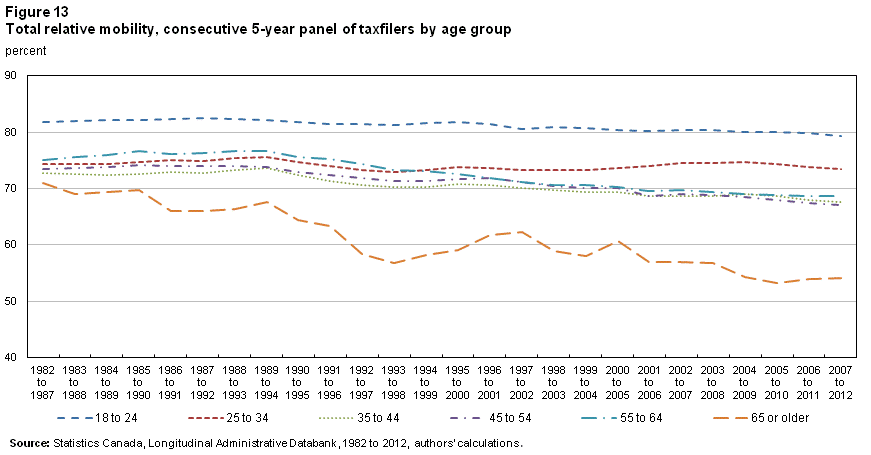
Description for Figure 13
The title of the graph is "Figure 13 Total relative mobility, consecutive 5-year panel of taxfilers by age group."
This is a line chart.
There are in total 26 categories in the horizontal axis. The vertical axis starts at 40 and ends at 90 with ticks every 10 points.
There are 6 series in this graph.
The vertical axis is "percent."
The units of the horizontal axis are years from 1982 to 2007.
The title of series 1 is "18 to 24."
The minimum value is 79.3 occurring in 2007.
The maximum value is 82.5 occurring in 1987.
The title of series 2 is "25 to 34."
The minimum value is 73.0 occurring in 1993.
The maximum value is 75.5 occurring in 1989.
The title of series 3 is "35 to 44."
The minimum value is 67.6 occurring in 2007.
The maximum value is 73.6 occurring in 1989.
The title of series 4 is "45 to 54."
The minimum value is 67.1 occurring in 2007.
The maximum value is 74.1 occurring in 1985 and 1986.
The title of series 5 is "55 to 64."
The minimum value is 68.6 occurring in 2007.
The maximum value is 76.7 occurring in 1985 and 1988.
The title of series 6 is "65 or older."
The minimum value is 53.3 occurring in 2005.
The maximum value is 71.1 occurring in 1982.
| 18 to 24 | 25 to 34 | 35 to 44 | 45 to 54 | 55 to 64 | 65 or older | |
|---|---|---|---|---|---|---|
| 1982 to 1987 | 81.7 | 74.3 | 72.7 | 73.4 | 75.1 | 71.1 |
| 1983 to 1988 | 81.9 | 74.4 | 72.5 | 73.7 | 75.6 | 69.0 |
| 1984 to 1989 | 82.1 | 74.4 | 72.4 | 73.9 | 75.9 | 69.4 |
| 1985 to 1990 | 82.2 | 74.7 | 72.6 | 74.1 | 76.7 | 69.8 |
| 1986 to 1991 | 82.4 | 75.1 | 73.0 | 74.1 | 76.1 | 66.0 |
| 1987 to 1992 | 82.5 | 75.0 | 72.7 | 74.0 | 76.3 | 66.1 |
| 1988 to 1993 | 82.4 | 75.4 | 73.3 | 74.0 | 76.7 | 66.3 |
| 1989 to 1994 | 82.1 | 75.5 | 73.6 | 73.8 | 76.6 | 67.6 |
| 1990 to 1995 | 81.7 | 74.7 | 72.4 | 73.0 | 75.6 | 64.4 |
| 1991 to 1996 | 81.4 | 73.9 | 71.3 | 72.3 | 75.3 | 63.4 |
| 1992 to 1997 | 81.3 | 73.3 | 70.6 | 71.8 | 74.4 | 58.4 |
| 1993 to 1998 | 81.3 | 73.0 | 70.3 | 71.4 | 73.3 | 56.7 |
| 1994 to 1999 | 81.5 | 73.2 | 70.2 | 71.4 | 73.0 | 58.2 |
| 1995 to 2000 | 81.8 | 73.8 | 70.8 | 71.8 | 72.5 | 59.1 |
| 1996 to 2001 | 81.4 | 73.7 | 70.5 | 71.9 | 71.8 | 61.8 |
| 1997 to 2002 | 80.6 | 73.3 | 70.0 | 71.2 | 71.2 | 62.2 |
| 1998 to 2003 | 80.9 | 73.3 | 69.7 | 70.5 | 70.6 | 59.0 |
| 1999 to 2004 | 80.7 | 73.3 | 69.4 | 70.0 | 70.6 | 58.1 |
| 2000 to 2005 | 80.3 | 73.6 | 69.4 | 70.1 | 70.2 | 60.7 |
| 2001 to 2006 | 80.2 | 73.9 | 68.6 | 68.7 | 69.6 | 57.0 |
| 2002 to 2007 | 80.4 | 74.5 | 68.7 | 69.1 | 69.7 | 56.9 |
| 2003 to 2008 | 80.3 | 74.5 | 68.6 | 68.8 | 69.4 | 56.8 |
| 2004 to 2009 | 80.1 | 74.6 | 69.0 | 68.5 | 69.1 | 54.4 |
| 2005 to 2010 | 79.9 | 74.4 | 68.6 | 68.0 | 68.8 | 53.3 |
| 2006 to 2011 | 79.8 | 73.9 | 68.0 | 67.5 | 68.7 | 54.0 |
| 2007 to 2012 | 79.3 | 73.5 | 67.6 | 67.1 | 68.6 | 54.1 |
| Source: Statistics Canada, Longitudinal Administrative Databank, 1982 to 2012, authors' calculations. | ||||||
The strong decline in total relative mobility for older taxfilers was associated with the strong decline in their upward mobility.Note 18 Our estimates suggest that the upward mobility for taxfilers aged 65 and older varied between 25% and 36% in the mid 1980s and early 1990s. However, during the last 15 years or so, only between 18% and 20% of these taxfilers moved up in any given 5-year period. For taxfilers aged 55 to 64, between 34% and 41% moved up in any 5-year period during the mid 1980s and early 1990s. However, more recently, the upward mobility for this group dropped to between 31% and 33%. On the other hand, the mild declines in total relative mobility for the two youngest groups were associated with the opposite movements in the upward and downward mobility. For taxfilers aged 18 to 24, our estimates indicate that the upward mobility increased slightly, while the downward mobility decreased slightly. Meanwhile, for taxfilers aged 25 to 34, the upward mobility went down, while the downward mobility went up moderately.
When looking across different income groups of Canadian taxfilers, we also see that total relative mobility declined, though the extent of the drop varied across income groups.Note 19 During the 1980s and the early 1990s, between 80% and 82% of taxfilers from the fifth, sixth, and seventh deciles changed income positions during any 5-year period.Note 20 This dropped to between 77% and 79% in the period leading up to the mid 2000s, and eventually decreased to the 74% to 76% level after the mid 2000s. Taxfilers in the top decile had the lowest total relative mobility. From the early 1980s to the late 1990s, their 5-year relative mobility varied between 45% and 48%. This dropped to between 43% and 44% after the late 1990s. However, taxfilers from the second and the third deciles experienced the strongest drop in relative mobility. For example, during the 1980s and the early 1990s, between 75% and 80% of taxfilers from the second decile changed income positions. This dropped to between 66% and 70% from the mid 1990s to the early 2000s and, more recently, it has gone down to vary between 61% and 62%.
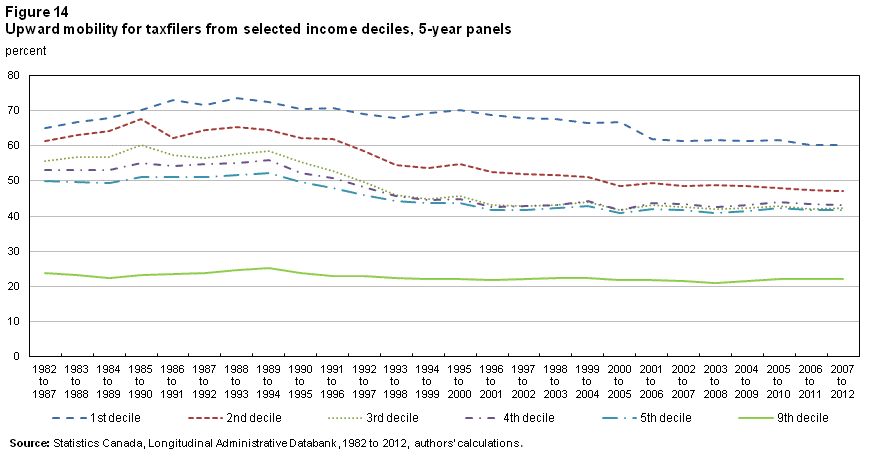
Description for Figure 14
The title of the graph is "Figure 14 Upward mobility for taxfilers from selected income deciles, 5-year panels."
This is a line chart.
There are in total 26 categories in the horizontal axis. The vertical axis starts at 0 and ends at 80 with ticks every 10 points.
There are 6 series in this graph.
The vertical axis is "percent."
The units of the horizontal axis are years from 1982 to 2007.
The title of series 1 is "1st decile."
The minimum value is 60.3 occurring in 2007.
The maximum value is 73.7 occurring in 1988.
The title of series 2 is "2nd decile."
The minimum value is 47.0 occurring in 2007.
The maximum value is 67.7 occurring in 1985.
The title of series 3 is "3rd decile."
The minimum value is 41.7 occurring in 2000.
The maximum value is 60.1 occurring in 1985.
The title of series 4 is "4th decile."
The minimum value is 41.9 occurring in 2000.
The maximum value is 55.9 occurring in 1989.
The title of series 5 is "5th decile."
The minimum value is 40.7 occurring in 2000.
The maximum value is 52.3 occurring in 1989.
The title of series 6 is "9th decile."
The minimum value is 21.0 occurring in 2003.
The maximum value is 25.1 occurring in 1989.
| 1st decile | 2nd decile | 3rd decile | 4th decile | 5th decile | 9th decile | |
|---|---|---|---|---|---|---|
| 1982 to 1987 | 65.1 | 61.4 | 55.7 | 53.1 | 50.1 | 23.7 |
| 1983 to 1988 | 66.7 | 63.2 | 56.9 | 53.2 | 49.8 | 23.1 |
| 1984 to 1989 | 68.0 | 64.2 | 56.9 | 53.1 | 49.4 | 22.5 |
| 1985 to 1990 | 70.3 | 67.7 | 60.1 | 55.1 | 51.0 | 23.1 |
| 1986 to 1991 | 72.9 | 62.1 | 57.4 | 54.4 | 51.0 | 23.6 |
| 1987 to 1992 | 71.7 | 64.4 | 56.6 | 54.7 | 51.2 | 23.8 |
| 1988 to 1993 | 73.7 | 65.2 | 57.7 | 55.2 | 51.6 | 24.6 |
| 1989 to 1994 | 72.4 | 64.6 | 58.6 | 55.9 | 52.3 | 25.1 |
| 1990 to 1995 | 70.5 | 62.1 | 55.5 | 52.2 | 49.7 | 23.8 |
| 1991 to 1996 | 70.7 | 61.9 | 52.9 | 50.8 | 48.0 | 23.1 |
| 1992 to 1997 | 69.1 | 58.6 | 49.7 | 48.4 | 46.1 | 22.8 |
| 1993 to 1998 | 68.0 | 54.7 | 46.0 | 45.8 | 44.2 | 22.3 |
| 1994 to 1999 | 69.2 | 53.7 | 44.9 | 44.6 | 43.6 | 22.0 |
| 1995 to 2000 | 70.1 | 54.7 | 45.8 | 44.8 | 43.6 | 22.1 |
| 1996 to 2001 | 68.8 | 52.4 | 43.2 | 42.5 | 41.6 | 21.7 |
| 1997 to 2002 | 67.9 | 51.9 | 43.0 | 42.8 | 41.7 | 22.0 |
| 1998 to 2003 | 67.6 | 51.6 | 43.2 | 43.2 | 42.2 | 22.2 |
| 1999 to 2004 | 66.5 | 51.3 | 44.1 | 44.3 | 42.8 | 22.2 |
| 2000 to 2005 | 66.8 | 48.6 | 41.7 | 41.9 | 40.7 | 21.8 |
| 2001 to 2006 | 62.0 | 49.5 | 43.1 | 43.6 | 42.0 | 21.8 |
| 2002 to 2007 | 61.5 | 48.6 | 42.7 | 43.3 | 41.7 | 21.4 |
| 2003 to 2008 | 61.7 | 48.8 | 42.0 | 42.7 | 41.0 | 21.0 |
| 2004 to 2009 | 61.3 | 48.6 | 42.3 | 43.1 | 41.4 | 21.4 |
| 2005 to 2010 | 61.7 | 48.0 | 42.7 | 43.9 | 42.4 | 22.0 |
| 2006 to 2011 | 60.4 | 47.4 | 42.1 | 43.3 | 41.8 | 22.1 |
| 2007 to 2012 | 60.3 | 47.0 | 42.4 | 43.2 | 41.6 | 22.1 |
| Source: Statistics Canada, Longitudinal Administrative Databank, 1982 to 2012, authors' calculations. | ||||||
The declines in total relative mobility across the income groups were largely associated with the drop in upward mobility that began in the late 1980s. All income groups experienced some drop in upward mobility (except for taxfilers from the top decile, who by definition cannot move any higher). But the drop was largest among taxfilers from the lower and middle deciles, suggesting that it might recently have become harder for Canadians from the lower and middle parts of the distribution to move up relative to other Canadians. As Figure 14 shows, from the late 1980s to the early 1990s, the upward mobility for taxfilers in the bottom decile varied between 70% and 74%. It subsequently dropped to 60%, beginning in the 2006-to-2011 period. Taxfilers from the second and third deciles experienced the strongest drops. For taxfilers in the second decile, the upward mobility varied from 64% to 68% in the late 1980s and the early 1990s. This dropped to about 47% by the 2006-to-2011 period. For taxfilers in the third decile, the upward mobility dropped from between 55% and 60% to about 42% over the same time span. However, for taxfilers from the eighth and the ninth deciles, the drops in upward mobility were quite small. For example, in the 1980s and the early 1990s, the upward mobility for taxfilers in the ninth decile varied between 23% and 24% and it only dropped slightly to between 21% and 22% more recently.
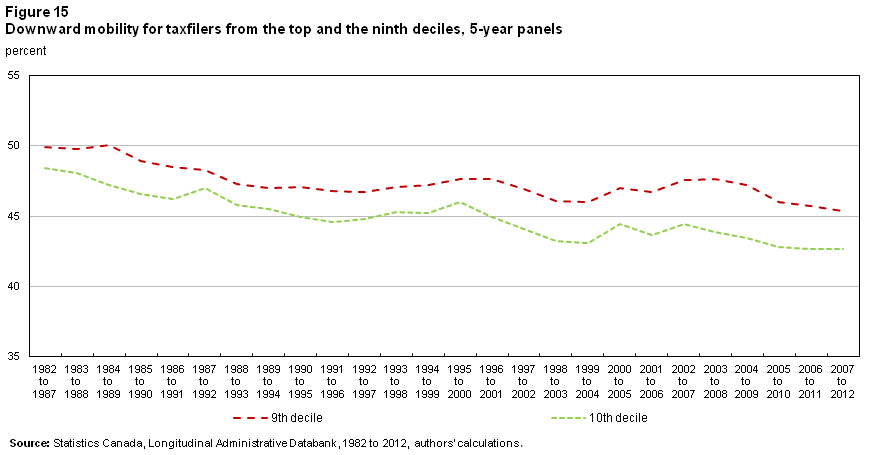
Description for Figure 15
The title of the graph is "Figure 15 Downward mobility for taxfilers from the top and the ninth deciles, 5-year panels."
This is a line chart.
There are in total 26 categories in the horizontal axis. The vertical axis starts at 35 and ends at 55 with ticks every 5 points.
There are 2 series in this graph.
The vertical axis is "percent."
The units of the horizontal axis are years from 1982 to 2007.
The title of series 1 is "9th decile."
The minimum value is 45.4 occurring in 2007.
The maximum value is 50.1 occurring in 1984.
The title of series 2 is "10th decile."
The minimum value is 42.6 occurring in 2006 and 2007.
The maximum value is 48.4 occurring in 1982.
| 9th decile | 10th decile | |
|---|---|---|
| 1982 to 1987 | 49.9 | 48.4 |
| 1983 to 1988 | 49.7 | 48.1 |
| 1984 to 1989 | 50.1 | 47.2 |
| 1985 to 1990 | 48.9 | 46.6 |
| 1986 to 1991 | 48.5 | 46.2 |
| 1987 to 1992 | 48.2 | 47.0 |
| 1988 to 1993 | 47.3 | 45.8 |
| 1989 to 1994 | 47.0 | 45.5 |
| 1990 to 1995 | 47.1 | 44.9 |
| 1991 to 1996 | 46.8 | 44.6 |
| 1992 to 1997 | 46.7 | 44.8 |
| 1993 to 1998 | 47.1 | 45.3 |
| 1994 to 1999 | 47.2 | 45.2 |
| 1995 to 2000 | 47.7 | 46.0 |
| 1996 to 2001 | 47.6 | 44.9 |
| 1997 to 2002 | 46.9 | 44.1 |
| 1998 to 2003 | 46.1 | 43.2 |
| 1999 to 2004 | 46.0 | 43.0 |
| 2000 to 2005 | 47.0 | 44.4 |
| 2001 to 2006 | 46.7 | 43.7 |
| 2002 to 2007 | 47.5 | 44.4 |
| 2003 to 2008 | 47.7 | 43.9 |
| 2004 to 2009 | 47.2 | 43.4 |
| 2005 to 2010 | 46.0 | 42.8 |
| 2006 to 2011 | 45.7 | 42.6 |
| 2007 to 2012 | 45.4 | 42.6 |
| Source: Statistics Canada, Longitudinal Administrative Databank, 1982 to 2012, authors' calculations. | ||
On the other hand, our result shows that the downward mobility for taxfilers from the upper part of the distribution dropped over time. The drop was not very strong, but the trend was solid. For example, Figure 15 shows that, in the early 1980s, about half of the taxfilers from the ninth decile moved down the income ladder over the 5-year observation periods. But, by the early 2000s, this number fell nearly 5 percentage points, leaving it at just above 45%. Taxfilers in the top decile experienced a 5 percentage-point drop over the same period, from about 48% in the early 1980s to about 43% by the early 2000s.
In this section, we found that total relative mobility among different groups of Canadian taxfilers dropped over time, and that this drop was largely associated with the declining upward mobility in the 1990s and declining downward mobility in the 2000s. Income mobility also varied between different groups of taxfiler. The oldest group of taxfilers experienced the strongest drop in their relative mobility, mainly associated with the declines in upward mobility. There were also important differences in upward mobility between income groups. Taxfilers from several lower income deciles experienced the strongest decline in their upward mobility, while taxfilers from the two top deciles became less likely to move down the distribution ladder.
Many researchers have documented that income inequality rose sharply between the mid 1990s and the early 2000s in Canada.Note 21 In this study, we have identified a similar movement in income mobility among Canadian taxfilers. In particular, we found that there was a sharp decline in upward mobility between the early 1990s and the early 2000s. It will be interesting to explore the mechanism by which income mobility might influence income inequality. This is the task of the next section.
5. Income mobility and inequality
Income mobility and income inequality are closely related. Higher income mobility tends to mitigate the impact of inequality, since mobility may smooth income variations over time (Jarvis and Jenkins, 1998). Hence, it is useful to gauge income mobility in a way that links mobility and inequality.
The Shorrocks M index is a classical mobility measure to link mobility and inequality. It indicates the extent to which inequality may be reduced over a prolonged observation period, because individuals are more likely to change income positions in a longer time period than in a shorter period. Hence, the index gauges income mobility as a means to mitigate long-term inequality. We can measure inequality using several alternative indexes but we choose to focus on the mean log deviation (MLD), the Gini, and the Theil indexes. The Gini and the Theil indexes are known to be sensitive to the middle of the income distribution, while the MLD index is more sensitive to the bottom of the income distribution than the Theil index.
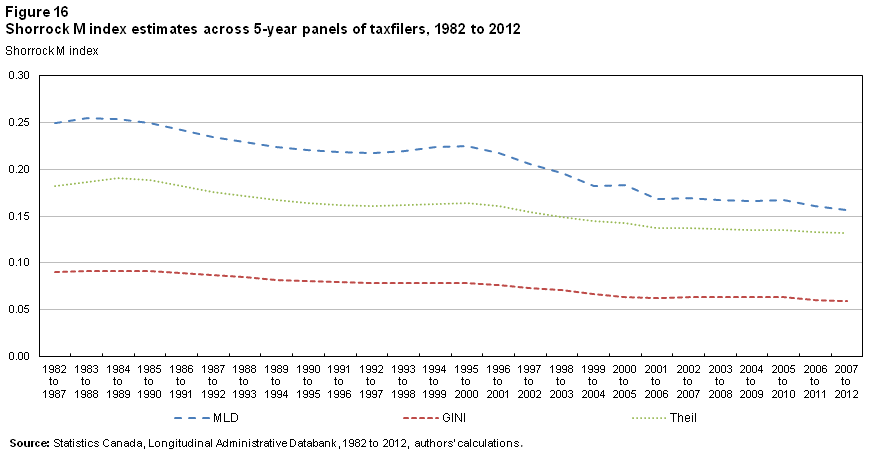
Description for Figure 16
The title of the graph is "Figure 16 Shorrock M index estimates across 5-year panels of taxfilers, 1982 to 2012."
This is a line chart.
There are in total 26 categories in the horizontal axis. The vertical axis starts at 0 and ends at 0.3 with ticks every 0.05 points.
There are 3 series in this graph.
The vertical axis is "Shorrock M index."
The units of the horizontal axis are years from 1982 to 2007.
The title of series 1 is "MLD."
The minimum value is 0.15645 occurring in 2007.
The maximum value is 0.25429 occurring in 1983.
The title of series 2 is "GINI."
The minimum value is 0.05970 occurring in 2007.
The maximum value is 0.09177 occurring in 1985.
The title of series 3 is "Theil."
The minimum value is 0.13139 occurring in 2007.
The maximum value is 0.19024 occurring in 1984.
| MLD | GINI | Theil | |
|---|---|---|---|
| 1982 to 1987 | 0.24932 | 0.09030 | 0.18163 |
| 1983 to 1988 | 0.25429 | 0.09097 | 0.18628 |
| 1984 to 1989 | 0.25363 | 0.09164 | 0.19024 |
| 1985 to 1990 | 0.24888 | 0.09177 | 0.18828 |
| 1986 to 1991 | 0.24155 | 0.08950 | 0.18159 |
| 1987 to 1992 | 0.23459 | 0.08693 | 0.17613 |
| 1988 to 1993 | 0.22962 | 0.08437 | 0.17162 |
| 1989 to 1994 | 0.22353 | 0.08210 | 0.16717 |
| 1990 to 1995 | 0.22078 | 0.08092 | 0.16375 |
| 1991 to 1996 | 0.21881 | 0.07948 | 0.16165 |
| 1992 to 1997 | 0.21684 | 0.07831 | 0.16085 |
| 1993 to 1998 | 0.21923 | 0.07862 | 0.16206 |
| 1994 to 1999 | 0.22334 | 0.07834 | 0.16267 |
| 1995 to 2000 | 0.22434 | 0.07852 | 0.16427 |
| 1996 to 2001 | 0.21745 | 0.07650 | 0.16088 |
| 1997 to 2002 | 0.20527 | 0.07303 | 0.15444 |
| 1998 to 2003 | 0.19551 | 0.07063 | 0.14928 |
| 1999 to 2004 | 0.18245 | 0.06713 | 0.14426 |
| 2000 to 2005 | 0.18324 | 0.06384 | 0.14274 |
| 2001 to 2006 | 0.16859 | 0.06275 | 0.13724 |
| 2002 to 2007 | 0.16980 | 0.06346 | 0.13743 |
| 2003 to 2008 | 0.16696 | 0.06373 | 0.13586 |
| 2004 to 2009 | 0.16585 | 0.06377 | 0.13539 |
| 2005 to 2010 | 0.16678 | 0.06336 | 0.13506 |
| 2006 to 2011 | 0.16035 | 0.06042 | 0.13318 |
| 2007 to 2012 | 0.15645 | 0.05970 | 0.13139 |
| Source: Statistics Canada, Longitudinal Administrative Databank, 1982 to 2012, authors' calculations. | |||
With data from 1982 to 2012, we could technically prolong the period of observation up to 30 years. However, our primary aim is to examine the trend of mobility, so it is more useful to use shorter periods and see the role of income mobility in reducing inequality over time. We chose to estimate the Shorrocks M index for each overlapping 5- and 10-year periods, beginning in 1982. Thus, the index for the period from 1982 to 1987 shows to what extent the observed inequality in 1982 would be mitigated if the observation period were lengthened to 5 years (until 1987), allowing people to change income positions. If inequality were not reduced, i.e., if permanent or longer-term income inequality were the same as the shorter-term inequality, the Shorrocks M index would be equal to 0. The index has a maximum value of 1, at which point short-term inequality would be completely wiped out by income mobility. When we estimate the Shorrocks M index for all overlapping 5- and 10-year periods from 1982 to 2012, we obtain a time series of the index. This series is intended to show how the impact of mobility on inequality evolved over time.
Figure 16 illustrates our estimates of the Shorrocks M indexes using the three different inequality measures for the overlapping 5-year periods from 1982 to 2012.Note 22 The results indicate that the impact of income mobility as an inequality mitigation factor has decreased for Canadian taxfilers during the past thirty years. As can be expected, the magnitudes of the Shorrocks M estimates were quite different when different inequality measures were employed, but the trends underlying the estimates were the same. Under the MLD index, the impact of mobility on inequality dropped from about 25% in the early 1980s to just above 15% by the 2007-to-2012 period. In other words, during the early 1980s, income mobility would reduce the MLD index by 25% if the observation period were to be extended from one year to five years. But, by the 2007-to-2012 period, once income smoothing was taken into consideration, mobility would only help reduce that inequality index by 15%. Under the Theil index, the impact of mobility in reducing inequality had dropped from about 19% to 13% during the thirty-year period. Similarly, under the Gini index, the Shorrocks M index dropped from about 9% to 6%, also pointing to a weakening impact of income mobility in mitigating inequality over time.
6. Conclusion
Statistics Canada regularly produces cross-sectional income statistics. These statistics are useful, but they provide little information on income mobility. While Canadian researchers have done much work in this area, the majority of the studies focused on the earnings mobility of the working-age population. As such, they draw only a partial picture of the economic mobility in Canada. This is because earnings are only one component of income, and the working-age population forms only part of the total population.
Using data from the LAD from 1982 to 2012, we examined the evolution of family income mobility from both the absolute and the relative perspectives for adult Canadian taxfilers over a thirty-year period. Our results suggest that absolute income mobility was higher from 1998 to 2012 than it was from 1982 to 1997. Several groups of taxfilers, such as those aged 35 to 44 and those that from the lower income deciles experienced higher absolute mobility than other taxfilers. However, the higher absolute mobility for the youngest taxfilers has dropped since 2000. The results also indicate that relative mobility followed a downward trend over the last thirty years. A declining proportion of taxfilers moved from one decile to another and, among those who changed income deciles, an increasing proportion moved only a very short distance. Across age groups, we found that, for taxfilers aged 65 or older, total relative mobility dropped, mainly driven by a drop in upward mobility. Across income groups, we found that upward mobility for taxfilers from the lower deciles and downward mobility for taxfilers from the top deciles declined, suggesting that taxfilers from both the bottom and the top deciles became less mobile more recently. Finally, we found that the influence of income mobility on income inequality began diminishing during the late 1980s, but became relatively stable by the early 2000s.
While our study identified several trends in family income mobility for Canadian taxfilers, it is not without caveats. As with other studies based on administrative sources, we were not able to link income mobility with some key individual characteristics, such as education and work experience. The data source also limited us from making inferences about the population as a whole since not all Canadians filed a tax return. However, the very large sample size and the relatively accurate income data enabled us to assess the evolution of income mobility for Canadian taxfilers—as a whole and for several specific groups. In the future, it would be desirable to extend the analysis to lower levels of geography, and to link mobility with industrial and occupational information.
References
Abbott, M. and C. Beach. 2013. "Immigrant earnings differences across admission categories and landing cohorts in Canada." Canadian Labour Market and Skill Research Network Working Paper no. 81.
Auten, G. and G. Gee. 2009. "Income Mobility in the United States: New Evidence from Income Tax Data." National Tax Journal LXII (2): 301–328.
Beach, C. 2006. "How has earnings mobility in Canada changed?" In Dimensions of Inequality in Canada. D. Green and J. Kesselman, eds. Vancouver: UBC Press.
Beach, C. and R. Finnie. 2004. "A Longitudinal Analysis of Earnings Change in Canada." Analytical Studies Branch Research Paper Series, no. 227. Ottawa: Statistics Canada. Catalogue no. 11F0019.
Bibi, S., J. Y. Duclos and A. Araar. 2011. "Mobility, taxation and Welfare." CIRPÉE Working Paper 1114. Québec.
Bradbury, K. 2011. "Trend in U.S. Family Income Mobility, 1969–2006." Federal Reserve Bank of Boston Working Paper no. 11–10.
Chen, W. 2009. "Cross-National Differences in Income Mobility: Evidence from Canada, the United States, Great Britain and Germany." Review of Income and Wealth 55 (1).
Clark, C. 1997. "Income dynamics: 1989 to 1994." Small Area and Administrative Data Division unpublished manuscript. Ottawa: Statistics Canada.
Corak, M. 2006. "Do poor children become poor adults? Lessons from a cross-country comparison of generational earnings mobility." Research on Economic Inequality 13 (1): 143–188.
Field, G. 2010. "Does income mobility equalize longer-term income? New measures of an old concept." Journal of Economic Inequality 8 (4): 404–427.
Finnie, R. 1999. "Earning mobility of Canadians." Perspectives on Labour and Income. Summer 1999. Ottawa: Statistics Canada. Catalogue no. 75-001-XPE.
Finnie, R. 2000. "The dynamics of poverty in Canada: What we know, what we can do?" C.D. Howe Institute Commentary, no. 145. Toronto.
Friedman, M. 1962. Capitalism and freedom. Chicago: University of Chicago Press.
Gittleman M. and M. Joyce. 1999. "Have family income mobility patterns changed?" Demography 36 (3): 299–314.
Hungerford, T. L. 2008. "Income Inequality, Income Mobility, and Economic Policy: U.S. Trends in the 1980s and 1990s." Federal Publications. Paper 501.
Jarvis, S. and S. Jenkins. 1998. "How much income mobility is there in Britain?" Economic Journal 108: 428–443.
Kennedy, B. 1989. "Mobility and instability in Canadian earnings." The Canadian Journal of Economics 22 (2): 383–394.
Lammam, C., A. Karabegović and N. Veldhuis. 2012. "Measuring Income Mobility in Canada." Studies in Economic Prosperity. November 2012. Vancouver: Fraser Institute.
Lu, Y., R. Morrissette and T. Shirle. 2011. "The growth of family earnings inequality in Canada, 1980–2005." Review of Income and Wealth 57 (1): 23–39.
Murphy B., A. Heisz and X. Zhang. 2015. "Poverty and Inequality Trends in Canada." In Welfare Reform in Canada. D. Beland and P.-M. Daigneault, eds. University of Toronto Press.
Shorrocks, A. 1978. "Income Inequality and Income Mobility." Journal of Economic Theory 19: 376–393.
Statistics Canada. 2011. Income in Canada 2009. Ottawa: Statistics Canada. Catalogue no. 75-202-XWE.
Statistics Canada. 2012. Income in Canada 2010. Ottawa: Statistics Canada. Catalogue no. 75-202-XWE.
Statistics Canada. 2013. Income Composition in Canada. Ottawa: Statistics Canada. Catalogue no. 99-014-X201100.
Notes
- Date modified:

